Top 3 Social Media Case Studies to Inspire You in 2024
Discover three successful social media case studies from top brands and learn how to create one. Benefit from their strategies and mistakes to ensure the success of your next campaign.

Social media is every marketer’s safe haven for branding and marketing.
And why not?
More than 50% of the population is active on social media, and more are signing up with every passing second.
In a recent poll by HubSpot, 79% of the respondents have made a purchase after seeing a paid advertisement on social media .
This isn’t just a happenstance.
It’s the constant efforts that these brands put behind their dynamic presence on social media, that counts.
But how do they captivate their customers’ attention for this long despite the budding competitors?
Well, that’s something that we’ll reveal in this blog.
We shall assess 3 different social media case studies by top brands who are best in their niches. Their game is simple yet effective.
How effective? Let’s take a look.

Social Media Case Study 1: Starbucks
Starbucks and social media are a match made in heaven. Being one of the sensational brands online, they are stirring the social media world with their strong presence.
They brew the right content to elevate the experiences of their coffee lovers. But how do they nail marketing with perfection every single time? Let’s find out.
Starbucks in Numbers
Starbucks mastered the advertising transition from offline fame to online undertaking. They use each social media with a varied goal to target pitch-perfect reach. Drawing in more customers than ever before, they strike the right balance in content across multiple platforms.
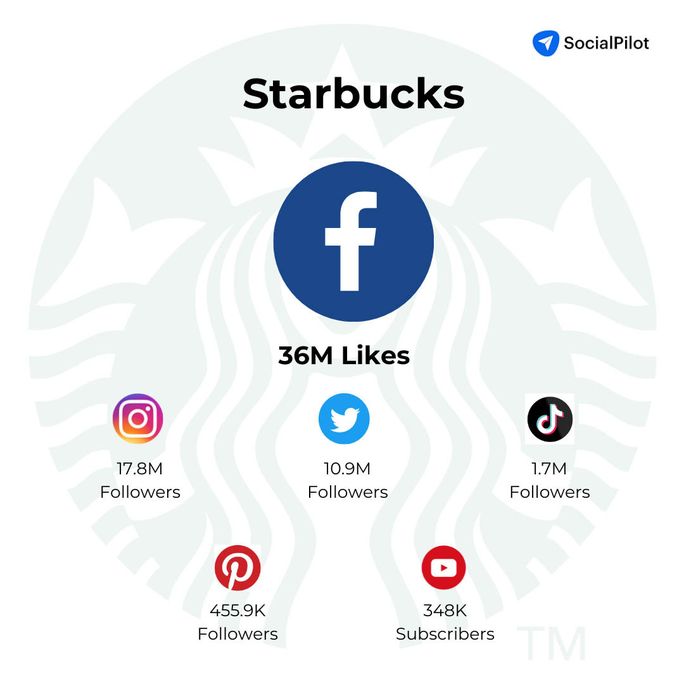
Key Takeaways
Though not every company has a Starbucks budget to promote and spend lavishly on social media marketing, here are some quick takeaways that will undoubtedly help.
1. Chasing Trends
Be it any event, brands must take the advantage to showcase their viewpoints and opinions. Successful brands like Starbucks jump into the bandwagon and leave no stone unturned to make their voice count in the trending list.
Here’s one such social media campaign example from Starbucks.
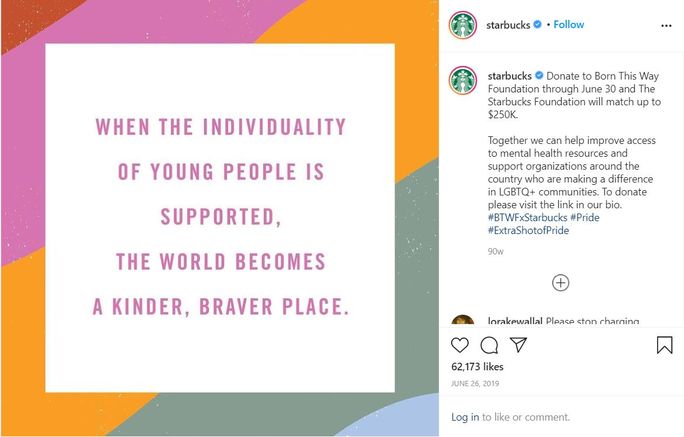
Starbucks is a firm believer in LGBTQ+ rights. When the pride wave surged, Starbucks came forward and reinstated its belief through the #ExtraShotOfPride campaign.
Starbucks joined hands with the Born This Way Foundation to raise $250K to support the LGBTQ+ community. Throughout the social media campaign, they shared quotes and stories of various Starbucks employees cherishing the pride spirit.
2. Less is More
Social media is not about quantity but quality. Starbucks follows the “less is more” principle to maintain the quality standards, even in the caption. Spamming followers’ feeds with constant posting is a big no-no. Starbucks shares 5-6 posts per week on Instagram and 3-4 weekly posts on Facebook .
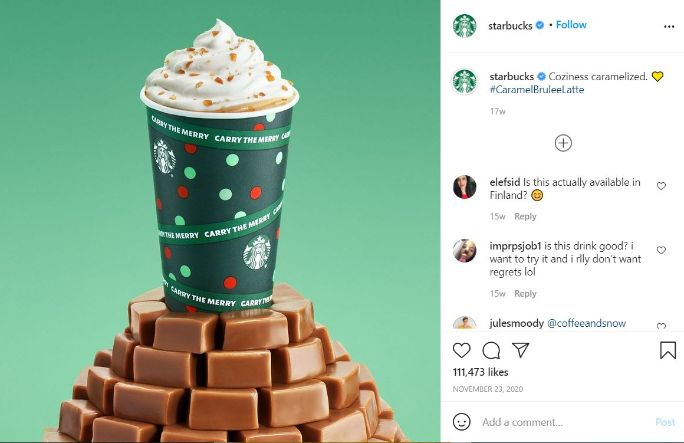
Creative and crisp! That’s what defines a Starbucks caption. This post with 111+k likes is no exception. Nothing is better than a minimalist post with a strong caption.
3. User Generated Content is the King
Ditch the worry of creating content every day when you can make use of user generated content. Starbucks makes sure to retweet or post its loyal customers’ content. User generated content postings starkly improve brand credibility.
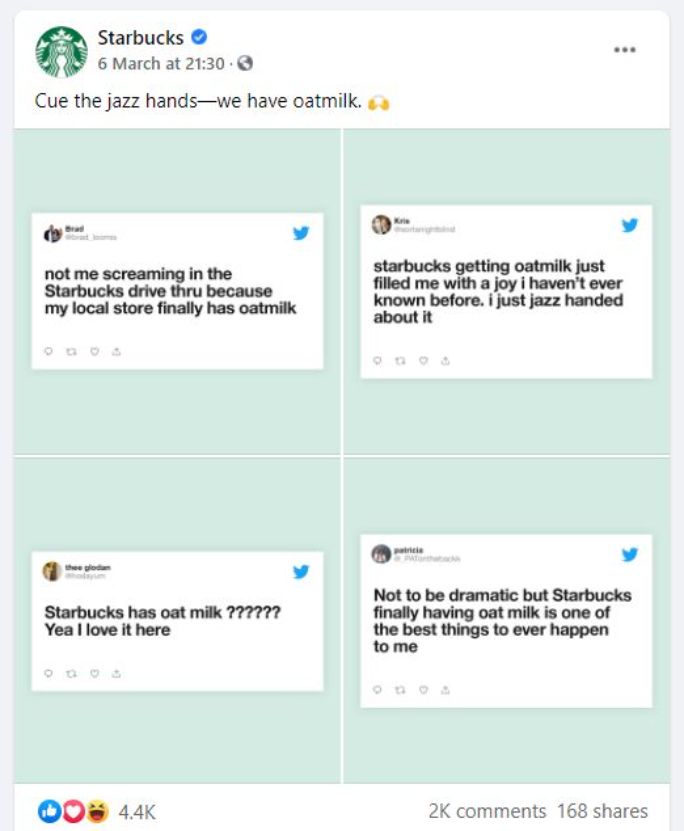
Look at this Facebook post made out of customers’ tweets. The new Oatmilk drink got the appreciation shower by some, and Starbucks couldn’t resist but share it with others. It saved them efforts on content brainstorming, plus they got free PR.
4. Building Rapport
Building rapport with the audience is an unsaid rule to brand fame. Social media has now taken the onus of dispensing quality service by aiding brands in prompting faster replies .
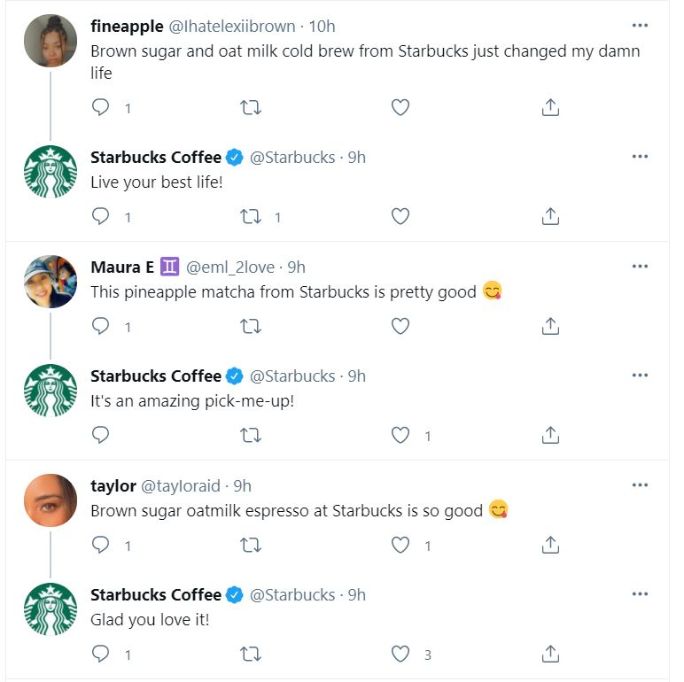
Starbucks is always on its toe to respond to customers actively solving concerns, expressing gratitude, or reposting. That kind of proactive service definitely deserves love and adoration.
5. Loads of campaigns
Starbucks is known for its innovative social media campaigns. Be it a new product launch or any festivity around the corner, Starbucks always turns up with a rewarding campaign.
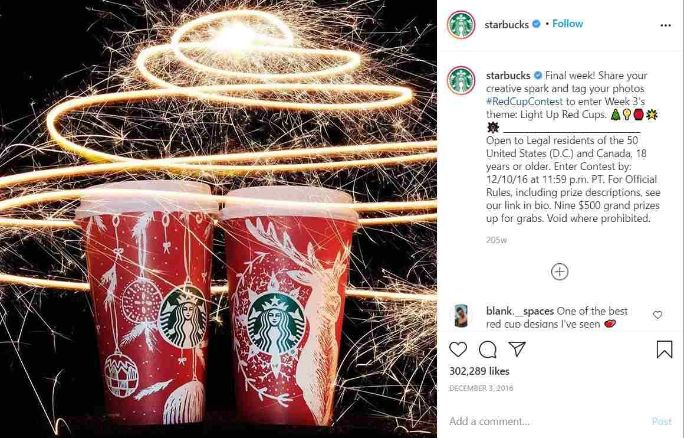
In this social media campaign example, Starbucks introduced #RedCupContest with prizes worth $4500 during Christmas of 2016. A new entry came every 14 seconds.
The grand total of entries was a whopping 40,000 in just two days. Indeed Starbucks knows how to get the most out of the festive fever.
6. Content mix
Last but not least, the content mix of Starbucks is inspiring. They create tailored content for every platform.
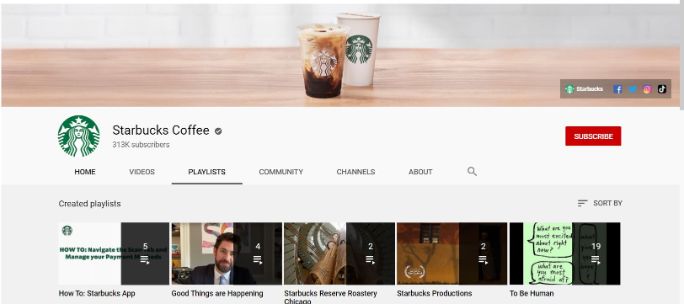
The official youtube channel of Starbucks comprises content in varied hues. From recipes to even series, Starbucks is the ultimate pioneer of experimenting.
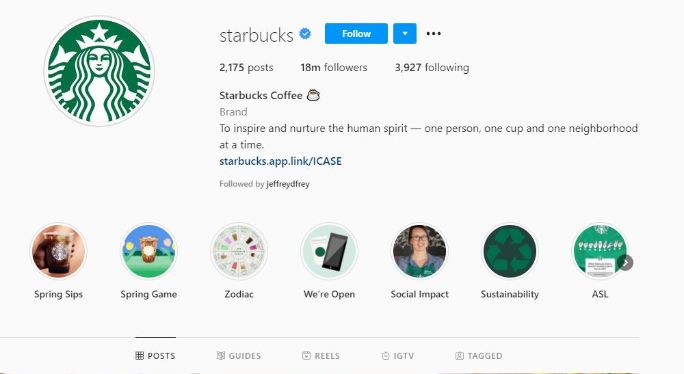
Even on Instagram, they use all the features like Guides, Reels, and IGTV without affecting their eye-popping feed. Starbucks also follows the design consistency for its aesthetic content mix.
Starbucks has proved time and again to be a customer-centric brand with their unrelenting efforts.
Social Media Case Study 2: Ogilvy & Mather
Ogilvy & Mather needs no introduction. Founded by David Ogilvy, the ‘Father of Advertising’ in 1948, the agency continues the legacy of revolutionizing marketing long before the advent of social media.
The iconic agency helps several Fortune 500 companies and more make a massive impact on their audiences worldwide.
Ogilvy & Mather knows its game too well and never fails to astonish. Not just high-profile clients, Ogilvy nails its marketing with perfection every single time.
Keep on reading.
Ogilvy & Mather in Numbers
They use social media to target pitch-perfect reach. Drawing in more hype than ever before, they know how to strike the right balance and bring out emotions with their heart-warming campaigns.
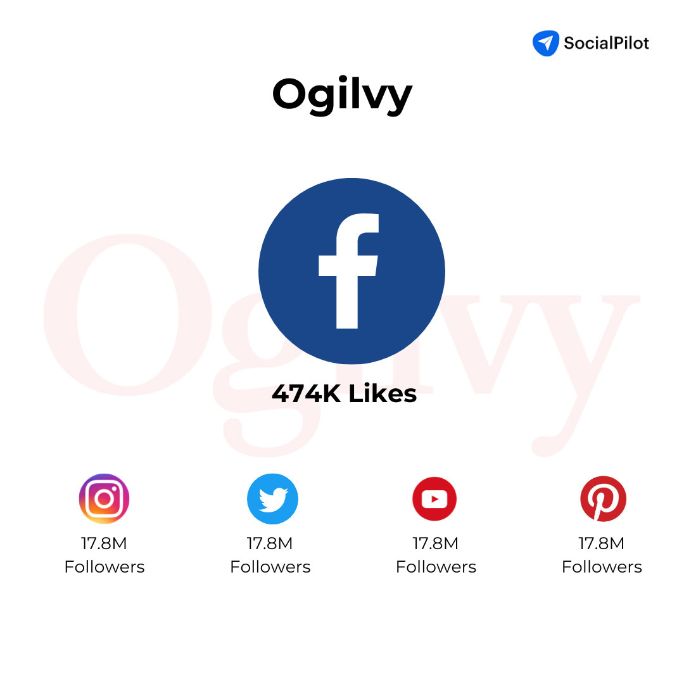
Not every company has David Ogilvy’s legacy or even affluent clients to boast of, but here are some quick takeaways that will undoubtedly help you become a pro marketer.
1. Integrating Values
Ogilvy stands apart from the crowd, creating trends. They leave no stone unturned to communicate values.
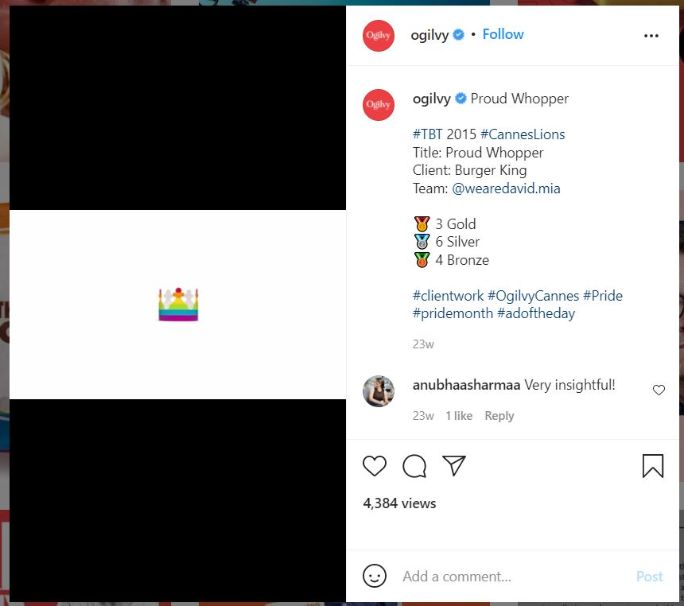
Proud Whopper is one such social media campaign by Ogilvy that was an instant hit on the internet. People were offered whoppers in rainbow-colored wrappers, with a note that said, “Everyone’s the same on the inside.” This was to reinstate the importance of LGTQ+ rights.
The campaign got 1.1 billion impressions, $21 million of earned media, 450,000 blog mentions, 7 million views, and became the #1 trending topic on Facebook and Twitter.
Ogilvy made a remarkable #Tbt video to honor this momentous event showcasing their supremacy in creating impactful campaigns.
2. Quality over Quantity
Ogilvy believes in the “ Quality supremacy ” to maintain their high standards, even in post captions.
Arbitrary posting isn’t a part of their agenda. They share 5-7 posts on Instagram and Facebook weekly.
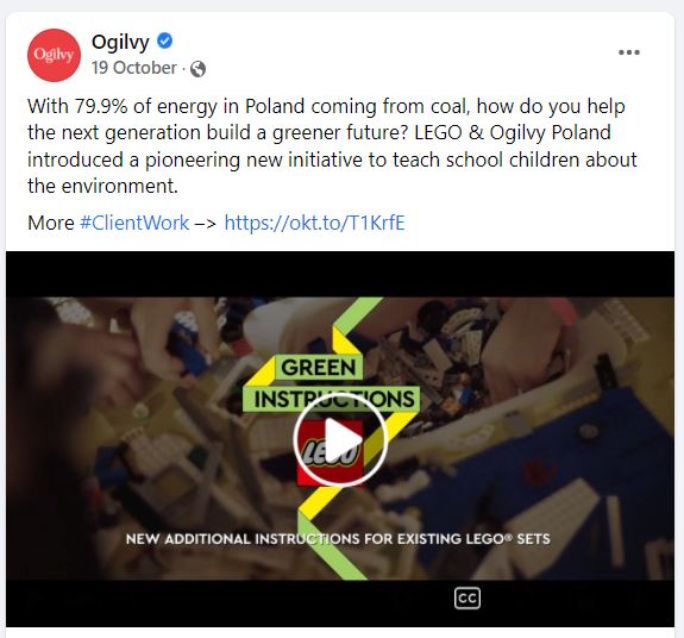
Direct and very precise. That’s what defines an Ogilvy caption. This post is no exception. They have exhibited the success of their client work by describing the motive behind the campaign and sharing the ad they created for raising awareness.
3. Adding Credibility
Won awards? It’s time to boast! Because that’s the most authentic way of establishing trust among your clients. It bears proof of your excellence.
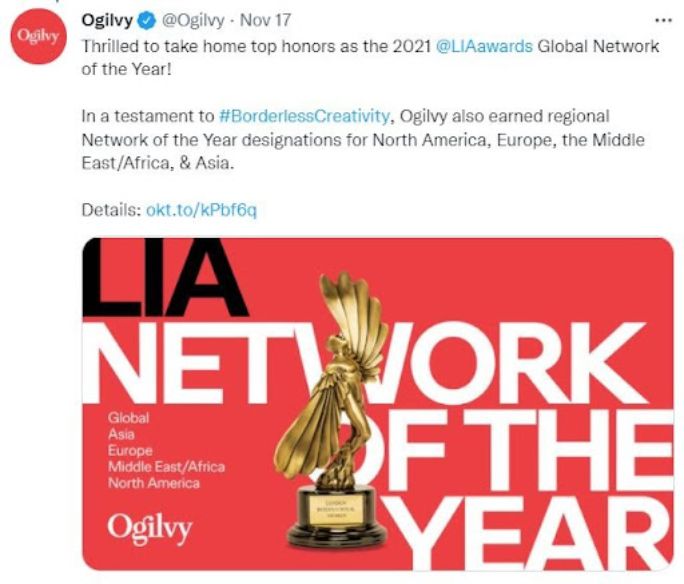
Look at this pinned Twitter post. Ogilvy won the Global Network of the Year by the very prestigious London International Awards. It also earned Regional Network of the year for Europe, the Middle East, Asia, and Europe.
What better than this to give its audience an idea about Ogilvy’s roaring success and undoubted potential?
4. Being Innovative
Building rapport with the audience is an unsaid rule to brand fame. And that’s why you need to tell stories. Social media has become an indispensable medium to spread your stories far and wide.
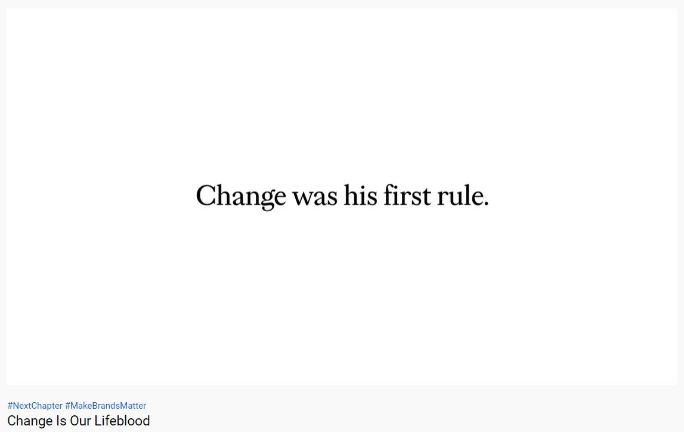
Ogilvy shares its historical tale of existence and how it has adapted to the challenges of the changing world. The team extensively talks about their adaptation to the latest trends to stay on top always.
5. Brainstorming Uniqueness
Being unique is what propels you on social media. People are always looking for brands that do something different from the herd. So your task each day is undeniably brainstorming unique content.
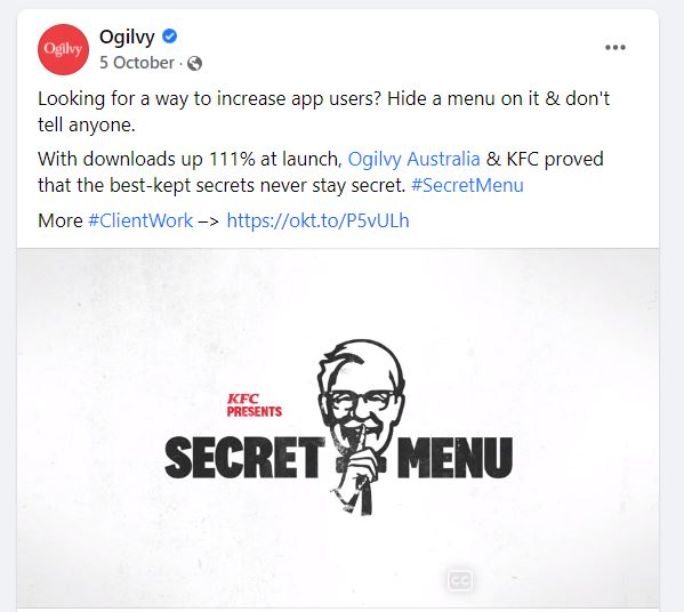
KFC wanted more of its customers to use its app. Well, Ogilvy and KFC decided to hide a secret menu in the app, which was a mass invitation for the download without being salesy at all. Results? Downloads up by 111% at launch!
6. Inspire Your Peeps
Inspiration is everywhere. But how do you channelize and mold it as per your brand guidelines? The renowned brands move their audience, filling them with a sense of realization. Who doesn’t seek validation? We all need quotes and inspiration to live by.
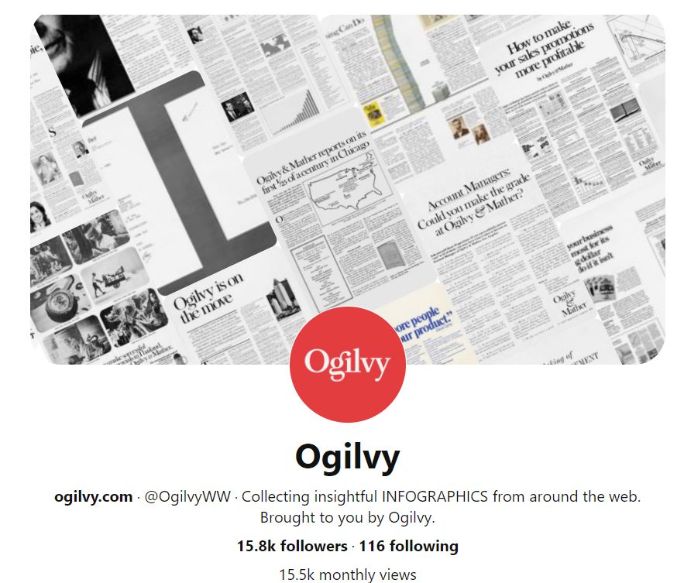
Ogilvy has dedicated its entire Pinterest profile to inspiration. The profile has numerous insightful infographics that encourage you to pursue marketing when your spirits run low. And that’s how it brings out the very essence of being the marketing leader: by inspiring its followers.
Got some good ideas for your branding? We have created templates and tools to help you execute them hassle-free. Tread on further and download the Trending Hashtag Kit for 2024 to get into action.
Social Media Case Study 3: PewDiePie
YouTube king with 111 Million subscribers on PewDiePie Channel, Felix Arvid Ulf Kjellberg, has defied all norms. One of the most prolific content creators of the decade, Felix was on the list of World’s 100 Most Influential People by Time Magazine in 2016.
Needless to say, he is still relevant to this day and has a massive following on social media. Not just for branding, the Swedish YouTuber leveraged social media to give himself a new identity and opened doors to fame and a successful career.
What was the cause of this extraordinary trajectory?
Let’s find out.
PewDiePie in Numbers
PewDiePie likes to keep his social media raw and unfiltered. That’s why subscribers love to have a glimpse of his everyday life and follow him on other social media platforms as well. Here’s a quick snapshot of that.
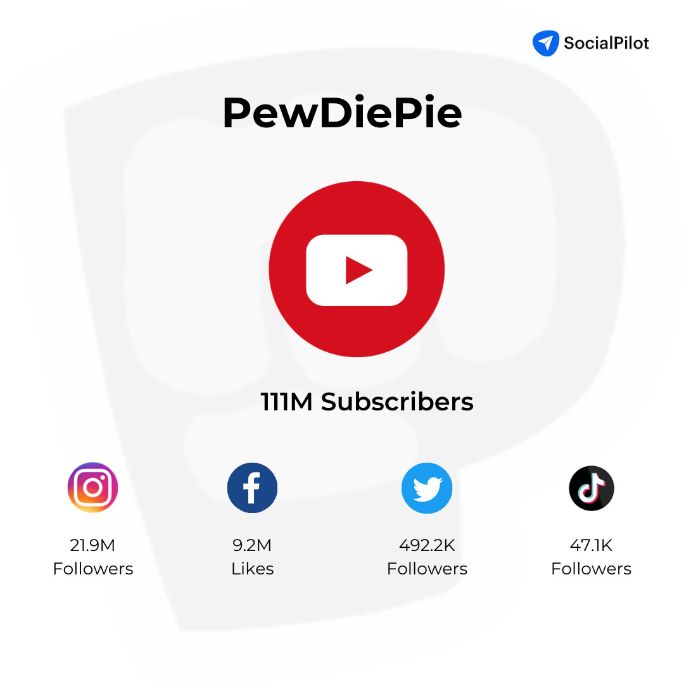
Felix took the early bird advantage and started creating content when it wasn’t even popular practice. We can’t go back in time, but we can definitely learn a lot from his social media success.
1. Start Now
If you are still skeptical about making the first move, then don’t. Stop waiting and experiment. It’s better late than never.
Social media is in favor of those who start early because then you create surplus content to hold your audience . You quench their thirst for more quality content.
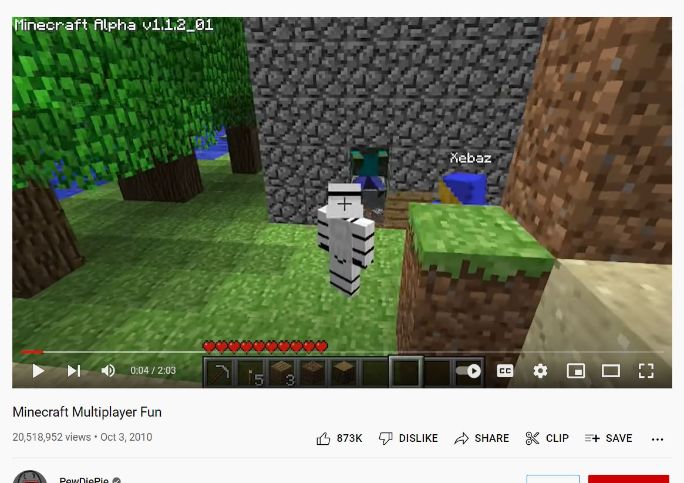
PewDiePie started creating videos in 2011 and live-streamed his gaming sessions with commentaries. It was something new and completely original. Ever since, he has continued to make thousands of videos that entertain his audience.
2. Gather Your Tribe
Being a content creator, PewDiePie knows his act of engaging his audience very well. He strives to build lasting connections and encourages two-way communication. As a result, his followers like to jump onto his exciting challenges.
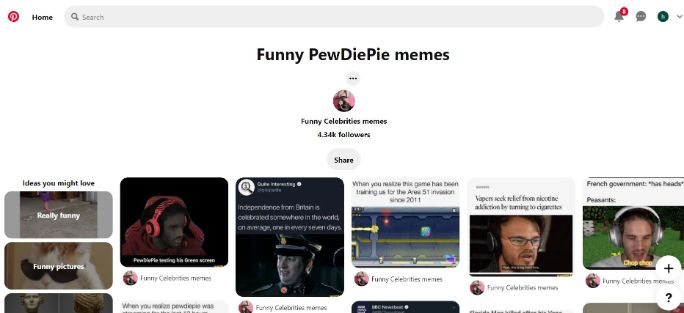
Felix treasures his gaming community. He frequently asks his followers to take screenshots and turn them into funny memes . He gives them tasks to keep them engaged and amused .
3. Collaboration and Fundraising
Once you reach the stage and gain popularity, people want to see more of you with their favorite personalities. That’s what Felix does.
He collaborates with multiple YouTubers and brands and puts out exclusive content for his followers. He also goes for multiple fundraising campaigns to support vital causes and social wellbeing.
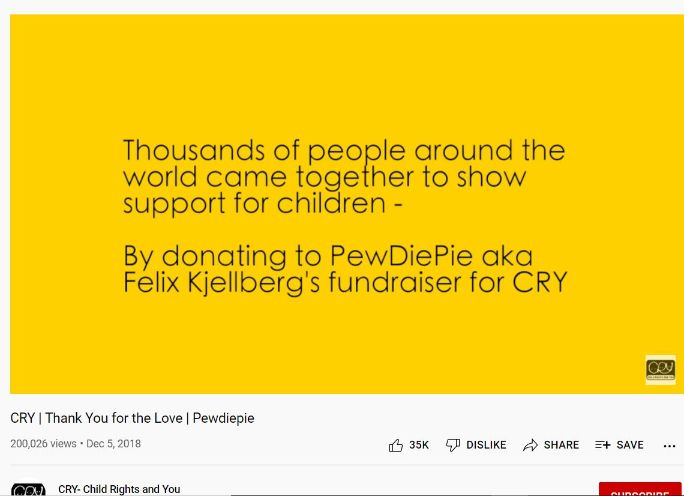
Here’s one such social media campaign example. PewDiePie supported the CRY foundation and raised $239000 in just one day to bring a positive impact for children in India. He thanked all for their contribution and taking active participation towards a noble cause.
4. Keep it Real
Felix likes to keep his content fluff-free. You get to witness raw emotions from an unfiltered life. This instantly appeals to the audience and makes the posts more relatable .
Apart from that, he also uses storytelling techniques to narrate his experiences, adding a very personalized touch to each of the videos.

Here’s a video of Felix where he and Ken from CinnamonToastKen discuss what can be possibly done with a million dollars around the world. The topic is quite intriguing.
More than 3.8M people have watched it and 216K of them liked it as well, proving that you need not always sweat to create complex content. Even the simplest ones can make the cut.
How to Write a Social Media Marketing Case Study
Many small businesses struggle when it comes to social media marketing. But guess what? Small businesses can slay the competition with a powerful tool: the social media case study.
These social media case studies are success stories that prove your hustle is paying off. Here’s how to weave a case study that showcases your small business wins:
Building Your Brag Book
- Pick Your Perfect Project: Did a specific social media campaign drive a surge in sales? Highlight a product launch that went viral. Choose a project with impressive results you can showcase.
- DIY Interview: Don’t have a fancy marketing team? No worries! Record yourself talking about your challenges, goals, and the strategies that made a difference.
- Data Dive: Track down social media analytics! Look for growth in followers, website traffic driven by social media, or engagement metrics that show your efforts are working.
Now that you have all the ingredients, it’s time to cook a brilliant case study
Crafting Your Case Study
- Headline Hunt: Grab attention with a clear and concise headline. Mention your business name and a key achievement (e.g., “From 100 to 10,000 Followers: How We Grew Our Bakery’s Social Buzz”).
- Subheading Scoop: Briefly summarize your success story in a subheading, piquing the reader’s interest and highlighting key takeaways.
- The Business Struggle: Be honest about the challenges you faced before tackling social media. This will build trust and allow other small businesses to connect.
- DIY Social Strategies: Share the social media tactics you used, such as engaging content formats, community-building strategies, or influencer collaborations.
- Numbers Don’t Lie: Integrate data and visuals to support your story. Include charts showcasing follower growth or screenshots of top-performing posts.
- Simple & Straightforward: Use clear, concise language that’s easy to understand. Bullet points and short paragraphs make your case study digestible and showcase your professionalism.
Remember: Your social media case study is a chance to celebrate your achievements and build businesses. So, tell your story with pride, showcase your data-driven results, and watch your brand recognition soar
Social media campaigns are winning hearts on every platform. However, their success rates largely depend on your year-round presence. That’s why being consistent really does the trick.
We’re sure you must have learned a few things from the above-mentioned social media case studies .
To excel further at your social media marketing, use our FREE Trending Hashtag Kit and fill your calendar with everyday content ideas.
On downloading, you get 3000+ hashtags based on each day’s theme or occasion. You also get editable design templates for hassle-free social media posting.
What are you waiting for? Download now.
Frequently Asked Questions
🌟 How do I start a social media campaign idea?
Here’s how you can start a social media campaign:
- Finalize your campaign goals
- Brainstorm personas
- Pick a social media channel
- Research your competitors and audience
- Finalize an idea that’s in trend
- Promote the campaign
- Start the campaign
- Track the performance
🌟 What are the different types of social media campaigns?
Different types of social media campaigns are:
- Influencer Campaigns
- Hashtag Challenges
🌟 Why is social media campaign important?
Social media campaigns have various benefits:
- Boost traffic
- Better Conversions
- Cost-effective Marketing
- Lead Generation
- PR & Branding
- Loyal Followers
🌟 What are some of the best social media campaign tools?
Some of the best social media campaign tools are:
- SocialPilot
🌟 What are the top social media sites?
The top social media sites are:
About the Author
Sparsh Sadhu
Related Posts

Manage social media effortlessly.
- Trial Begins Immediately
- No CC Required
- Change Plans Anytime
- Cancel Anytime
Start Your 14-Day Free Trial
Integrations
More on Social Media
- © 2024 SocialPilot Technologies Inc. All Rights Reserved.
- Privacy Policy & GDPR
- Terms of Service
- Cookie Settings
- Follow us :
7 Successful Product Launch Examples That’ll Inspire You
How do you pull off a successful product launch here are 7 case studies to inspire your own strategy..
As a brand, orchestrating a successful product launch is a lot like getting up on stage as a stand-up comedian.
No matter how confident you are that people will like your product and you’ll have a successful product launch, you can never quite shake the fear that all you’ll hear is crickets.
According to Five By Five Global , three-fifths of people weren’t aware of any new launches in the past 12 months, which doesn’t make for great reading if you launched something last year (or are planning to in the near future).
But that doesn’t mean what you’ve created is bad.
It means that it hasn’t been marketed right.
To show you how to avoid the deafening silence of no one noticing your product, we’ve picked out seven of the most successful product launch examples of recent years to inspire your launch marketing efforts, along with some tips on how to implement the tactics.
Let’s dig in.
1. Nütrl Vodka Soda
What they did
When Goodridge & Williams Distillers came up with Nütrl Vodka Soda it faced a big problem — consumers were struggling to believe the core claim that the drink contained only Nütrl Vodka, carbonated water, and natural lemon juice. It needed a way to get people to buy into what they were selling, which was that their product is something healthier than wines and beers containing artificial flavors and sweeteners. They did this with playful videos aimed at men and women who enjoy vodka soda cocktails. With such a broad target market, the company ran its 30-second ads of people “breaking up” with wine and beer during sports games on TV and on social media via co-op Facebook ads with retailers. The campaign helped the drink become the fastest-growing ready-to-drink vodka soda in Canada.
What you can do
Embrace video marketing. Check out these statistics :
- 45% of people watch an hour or more of video per day
- Facebook gets 8 billion video views a day
- 79% of consumers prefer watching a video to reading about a product
- 84% of consumers have bought something after watching a video
- Video marketers get 66% more qualified leads per year
- Video marketers achieve a 54% increase in brand awareness
Those numbers tell you everything you need to know. People love video and using it increases brand awareness and sales. Create short, snappy videos that get your key message across in a way that encourages sharing. Some things to keep in mind when doing this:
- 56% of all videos published in the last year are less than two minutes long . That’s because attention spans are dwindling. Some studies actually put humans on par with goldfish.
- 85% of Facebook video is watched with the sound off. Your story needs to be understood without audio, using accurate captions to accompany speech.

Harry’s biggest selling point is simple: they offer custom-made razor blades at affordable prices — cheaper than more well-known alternatives. The problem is, cheaper doesn’t automatically equal more customers. People still need to be convinced. Harry’s did (and still does) this convincing with a trial offer featured prominently on its website and in social media ads which then drive traffic to a landing page. The simple tactic has helped the company grow into a giant of online retailing with three million monthly recurring customers and counting, and $200 million in revenue in 2017 alone.
Create a trial offer.
A trial offer is a great way to convince customers that are on the shelf. It’s you putting your money where your mouth is. The ball is fully in the customer’s court. If they try it and don’t like it, they don’t have to buy it. The friction of buying a product they don’t fully know is eliminated. What’s more, customers also enter the marketing funnel as a promising lead. They’re interested enough to try the product, which means they’re open to hearing more about what you have to offer. Make trial offers easy for customers to claim with a simple message and calls-to-action. For example, Harry’s has the trial offer front and center on its homepage. That clicks-through to a page that makes ordering simple.

Have as few steps as possible between landing on your website and walking away with a trial.
3. Robinhood

Robinhood is a stock-trading service that lets customers easily trade with $0 commission. It’s also the gold-standard when it comes to building a waiting list. In the year leading up to the launch of its service, Robinhood invited people to gain invitation-only access to its private beta — giving them the chance to be among the first to benefit from what was on offer. The message was simple:
“$0 commission stock trading. Stop paying up to $10 for every trade.”
And there was only one option: Opt-in.
By opting in, users were placed on the waiting list and shown a “thank you” page displaying their position on the list, along with the chance to gain priority access by inviting friends and family to join. And the more people a person got to join, the sooner access would be granted. By doing this, Robinhood created a game. People wanted to jump the queue so they’d invite everyone they could.

The result:
Nearly one million opt-ins. (Now that’s a successful product launch!)
Built a waiting list.
A waiting list driven by incentives like sharing to earn special privileges can help create exponential growth. It allows you to build a database of actively interested users, builds hype for your product, and lets you engage with customers to gather feedback on beta launches. Create a landing page for your new product launch that makes it easy for people to opt-in, making sure to include the following elements
- Strong benefit-focused headline
- Clean, distraction-free landing page design
- Clear call-to-action
- Simple sign-up
Once people have opted-in, keep them interested in your brand and product by sending them useful information. For example, if you were launching software that helps customers with their online shopping by finding the cheapest products, you could send weekly newsletters with curated suggestions on how to save money on shopping or meal recipes or low-cost gift ideas. Every email gives your waiting list value and maintains an interest in your launch.
4. Unsplash

Image: Unsplash
As a way to thank photographers that had contributed photos to help its site to 50 million downloads, Unsplash launched a Kickstarter campaign for a book featuring inspiring photos and essays from creators. The goal for the campaign was to raise $75,000, however, they were able to exceed this target by $25,000. How? By getting influencers involved. The work in the book was curated to include key people in the creative industry and their influence helped catapult the book to new levels.
Partner with influencers.
70% of millennial consumers are influenced by the recommendations of their peers in buying decisions. And with 26% of desktop users and 15% of mobile users using ad blockers to hide traditional ads, using an influencer might well be the most effective way to reach your target audience. According to a study by Nielsen Catalina Solutions and TapInfluence, the ROI of influencer content is 11X greater than traditional campaigns. That’s because influencers quickly build trust and relationships, and improve brand awareness. Find popular people in your niche and reach out. SproutSocial suggests the following tips for breaking the ice on LinkedIn, but they can be applied across all social channels:
- Start liking their shares and posts before adding them to your network
- Send a meaningful message about their content
- Ask them to join one of your LinkedIn groups (or join theirs)
- Let them know how you found them (be honest)
- Explain you’d just like a moment of their time (value their time)
When you’ve found influencers, discuss ways to collaborate. There are a number of ways you can do this:
- Guest blog posts
- Sponsored content
- Affiliate arrangement
- Product reviews
5. Tommee Tippee

In trying to gather momentum for a campaign aimed at encouraging moms to trust their paternal instincts, Tommee Tippee took a uniting problem and turned it into a PR stunt. That being the often useless, unneeded advice from others about how to parent. Tommee Tippee turned parenting help books into limited-edition baby wipes as a way for moms to literally wipe butts with other people’s advice. In doing so, it created a useful product that supported its main aim: to get eyes on the brand. The launch helped increase awareness, not only in the brand’s #ParentOn theme but in the brand itself as it tried to penetrate the U.S. market.
Turn engineering into marketing.
Listen to your audience and create experiences around their needs. Find their problems and create something that solves them. Another example of engineering as marketing is from Hitlist , a website that helps users find the best deals on flights and travel deals. It created the Wandertab — a Google Chrome extension that shows users a stunning photo from an amazing place, as well as how much it costs to go there, info from friends, and travel tips whenever a new tab is opened. It’s useful for travelers as it allows them to explore destinations and enjoy targeted alerts, while still achieving the brand’s main aim: getting people to use its service. Provide something that gives value to the customer. This will help to build trust and make people more receptive to what you want them to do or hear.
6. Absolut Vodka
When Absolut wanted to engage young consumers with its release of a limited edition “Unique” vodka in Argentina, it decided to throw a launch party which involved people interacting with a fictional doorman named “Sven” via WhatsApp. A WhatsApp number was released on all Absolut marketing and advertising materials with details on what to do — charm Sven to get yourself on the guest list. Cue all kinds of hilarious messages and a huge social buzz around the product launch. Through WhatsApp, Absolut was able to enjoy three days of uninterrupted chat with over 600 contacts, during which more than 1000 images, videos, and audio messages were created. All for the price of a sim card.
Explore new channels for your launch marketing.
Find out where your audience is and reach them there. Listen to your audience, research the market and test new channels. Not every channel you test will be of value, but if you keep exploring and tweaking, you’ll eventually find an untapped niche that offers good ROI. Keep in mind that marketers tend to overuse marketing platforms to the point where they’re no longer of any benefit (see: Facebook organic reach), so stay ahead of the curve by reading industry publications like Search Engine Journal , Marketing Land and Search Engine Watch to identify new channels.

Taking on the competition is nothing new in product launch marketing. Think Coca-Cola vs. Pepsi, Samsung vs. Apple, and Xbox vs. PlayStation. When PayPal received some negative publicity around freezing member accounts, WePay saw an opportunity to get one over on its competitor. During PayPal’s annual developer conference, WePay showed up and dropped a huge block of ice with frozen money and a simple message to PayPal users:
PayPal Freezes Your Accounts
It wanted people to know that the same thing wouldn’t happen to its users. And it worked. An hour and a half after the ice arrived, the stunt was on the front page of TechCrunch and other popular tech sites. The publicity resulted in:
- 3x more conversions on the stunt landing page
- 225% increase in traffic
- 300% increase in signups
Not bad for a startup with a limited marketing budget.
Promote your strengths through competitive marketing.
You can do this in a number of ways:
- Target Facebook users whose interests include your competitors with ads related to your product
- Run targeted video ads that show whenever a user searches for YouTube videos related to the competition
- Target the Twitter followers of competitors
- Use Google Ads custom affinity audiences to target the websites of competitors
- Come up with a wacky PR stunt à la WePay
When targeting competitors, it’s important to compare yourself to the market leader. It makes no sense going after someone smaller. In doing so you’ll come across as a bit of a bully which will leave a negative impression. Get your message across in a fun, engaging way that promotes your strengths. In order to tempt consumers away from the big boys and over to your product, focus on hitting what the ReWired Group call the four forces that influence a customer’s decision to switch products .
- Problem with current product — show how well your product solves the customer’s problem
- Attraction of new product — highlight where your product betters the competition
- Anxiety and uncertainty of change — show customers how simple it is to make the switch
- Existing habits and allegiances — change the customer’s thinking by reducing their attachment to a product
How to create your project launch marketing plan
To launch your product successfully using any of the methods we’ve talked about, you’re going to need a plan. As with every good plan, that starts by establishing some goals and objectives. You can do this by answering this single question:
What does a successful product launch look like?
Do you want more sales? More leads? An increase in traffic or signups? Or do you just want to raise awareness for your product and brand? When you’ve decided on the objectives and goals, you can begin putting together a product launch strategy that delivers results. This can be done in four steps:
Step 1: Define your target audience
Find your target audience using demographics, interests, job title, and locations and then go beyond this to find their pain points. Be clear about who your audience is, their problems, and why they should care about your product.
Step 2: Establish your unique value proposition (UVP)
What do you do that competitors don’t? In the case of Robinhood, it was offering $0 commission trading in a market where $10 is standard. Establish what makes you different and build your message around it. Your UVP is what will spark interest in consumers and influencers and drive conversions.
Step 3: Find the influencers
Who are the key figures in your niche? A well-defined target audience will make it easy to find them. Look for the bloggers, social media celebrities, and reporters that can help your product gain traction. Target them with good, valuable content and offers that benefit them as much as you.
Step 4: Plan your content marketing
The success of your product launch comes down to how well you market your product. This means providing valuable content on the channels where your audience hangs out. It’s important to test and tweak different types of content and measure results. Depending on your audience, videos might be more beneficial than blog posts and social media might be more effective than media coverage.
Launching a new product is about creating a buzz — getting people to give you a second look and choose you over the competition. And, as we’ve shown here, there is no shortage of ways to do it. But choose your tactics wisely.
- Research the market
- Find the channels where your audience hangs out
- Play to your strengths
- Create a successful product launch marketing plan based on your goals
- Maybe even hire a growth marketing agency to help along the way 😉
Combine these elements, along with one or more of the strategies we’ve talked about, and you’ll give your product the best chance of a successful product launch.
Jim Huffman
Founder & CEO GrowthHit. Startup mentor at Techstars, General Assembly, and Sephora Accelerator. Author of The Growth Marketer’s Playbook #1
Most Popular Posts
How to grow a dtc brand to 8-figures (23 step process), 13 reasons why people don’t convert & how to fix them [39 case studies], offer-led growth: how to fix your customer acquisition problem [17 case studies], breaking news: we acquired neat apparel, the strategic growth calendar framework: a 12-month blueprint for scaling your company, growth strategy 101: 9 questions to help uncover your unique growth strategy, 101 marketing tools to help grow your business [database], neat’s rebrand : product detail page (sneak peek), related posts.

How do you grow a D$C brand from idea to 8 figures? After working with 100+ brands at my growth agency, I have seen…

Email Marketing Best Practices for Businesses in 2024
Email marketing best practices remain a powerful tool in today’s digital landscape. Despite the rise of social media and other communication channels, email boasts…

5 Powerful Small Business Growth Strategies
Every entrepreneur dreams of their small business blossoming into a thriving success story. But in the competitive market, growth can feel like a mythical…

The Offer-Led Growth framework is a way to guarantee sales by building your growth strategy around your irresistible offer. We break down how to…

SEO Audit Checklist for Small Businesses: Improving Your Online Presence
In the ever-evolving landscape of the digital world, search engine optimization (SEO) has become an indispensable tool for small businesses seeking to thrive in…

My Failed Attempt at Being an Influencer
We bought a brand, Neat – sweat-proof clothes. Follow along to see how we’re growing it. SEE ALL THE UPDATES HERE. Sometimes being a…

A Recap of Neat’s 2023 Black Friday Cyber Monday Results
We bought a brand, Neat – sweat-proof clothes. Follow along to see how we’re growing it. SEE ALL THE UPDATES HERE. After signing the…

The Secret Hack I’m Doing to Craft Neat’s Growth Plan
We bought a brand, Neat – sweat-proof clothes. Follow along to see how we’re growing it. SEE ALL THE UPDATES HERE. What was my…

Scaling a Business: A Brain Balfour – Approved Guide
So, you want to scale your business? Great! Scaling is one of the most exciting and rewarding parts of being an entrepreneur. We’ll provide…

E-commerce Success Unveiled: Mastering Online Growth
Hello, fellow e-commerce trailblazers. Brace yourself because we’re about to embark on a journey into the world of e-commerce growth strategy. The digital marketplace…
The #1 Newsletter for Growth Marketers & CEOs
The best kept secrets in growth. Every Thursday you’ll get:
- 3 must-read articles
- 1 podcast episode
- Sneak peek at our startup studio

Join the 5,000+ subscribers

Learn How 17 High Growth Brands Get Customers to Say
...“shut up and take my money” (includes examples).


A Guide How to Create Social Media Case Studies that Convert (with Template)
As you already know, moving leads through the sales pipeline is no easy feat. In the world of digital marketing, it takes an average of 18-21 touchpoints to convert a lead. If you want any chance of pushing prospects down the funnel, you have to directly communicate the value of your product or service and one of the best ways to do this is with case studies.
Putting together a compelling social media marketing case study is one of the most powerful strategies for attracting future customers or digital agency clients. But it’s not easy. In this article, we’ll go over the ingredients of a winning case study and how to deliver said case study in the most effective way. We’ll also include a template that you can go by.
Let’s dive right in.
The importance of social media case studies
There’s a lot of content out there. Your potential customers are constantly bombarded with whitepapers, e-books, 10-step guides, newsletters and unpalatable sales hype. To get the attention of prospects today you have to demonstrate your product or service’s value, not just talk about it.
B2B buyers today don’t have time to interpret marketing messages that aren’t concise and relevant. That means that instead of aimlessly beating around the bush about how great your company is and how terrific your products are, you have to share the real-life experiences customers are having with you and your products.

Traditional marketing tactics don’t work anymore. We already know that. People nowadays drive their own buying decisions through online research and the importance of social proof cannot be understated.
About 57% of the customers will only use or buy a business service if it has at least 4 or five-star ratings. It should be noted however that reviews aren’t enough. In fact, 88% of consumers view ratings and reviews as a personal suggestion, not definitive proof of a product’s efficacy.
Reviews are all well and good but if you’re marketing B2B software or agency services, creating in-depth, data-driven case studies is the way to go. Case studies are extremely effective in the consideration stage of the buyer’s journey when they are actively comparing solutions and providers to solve a problem they’re experiencing.
As we already mentioned, your prospects are actively researching your products and there’s a 100% chance that they will stumble upon content from your competitors. Having relevant resources like case studies can cement your brand as an authority figure.
Now that you know why case studies are important it’s time to tackle the creation process.
The ingredients for a perfect case study
1. detailed and full of data .
Have you ever read a case study where a business states they “doubled traffic” for the customer in their case study, and wondered if that meant they went from 50 to 100 visits or 5,000 to 10,000 visits?
The point of a case study is to highlight the exact ways your product or service has helped a customer. The most compelling case studies hit prospects in the face with how amazing your customers’ results were, meaning you need to include numbers. Lots of them. Here’s an example:
Instead of saying “How client X got more sales thanks to us”, use “How client X increased their sales by X% in X days thanks to us”
This step may sound like a no-brainer but it’s absolutely essential to use relevant data when crafting your social media case study, especially if you run a digital agency. Include statistics like a decrease in ad spend, an improvement in engagement or increase in organic followers.
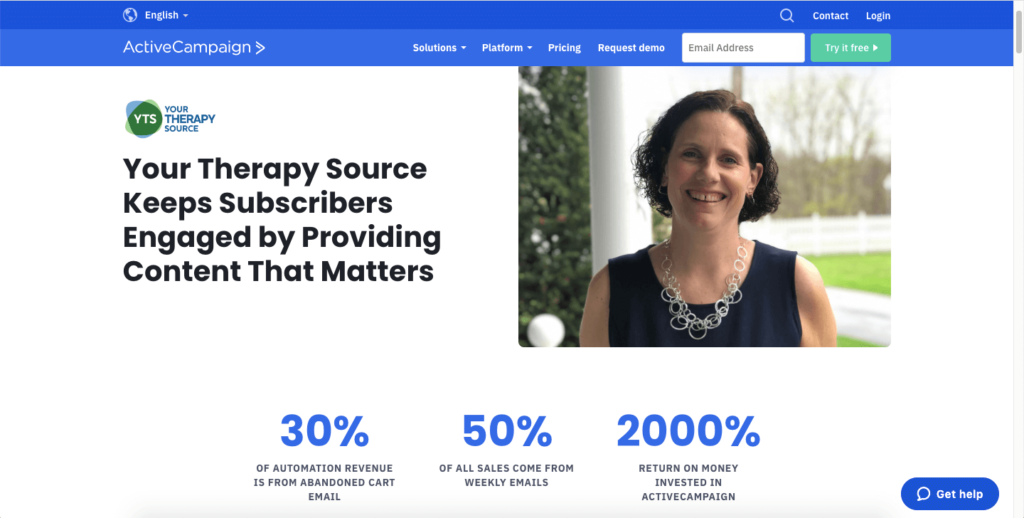
It’s important to remember that not everyone is as familiar with analytics and KPIs as you are, so break down the complicated sections into digestible bits that anyone can understand. Provide context as you go along so the data flows with the overall narrative of the case study.
Include some eye-catching visuals like picture proof or real-time dashboards so the reader can envision the positive potential of your product or service.
2. A complete, compelling story
Storytelling is a powerful marketing strategy that has stood the test of time. A great social media case study uses narrative techniques to put readers in the subject’s shoes.
When crafting your subject’s persona, be sure to include:
- Who is the sample customer, what do they do and why do they do it?
- What were the customer’s goals?
- What were the customer’s needs?
- How did you satisfy those needs and help the customer meet their goals?
As a rule of thumb, structure your case study by splitting up the main takeaways into three easy snippets: The challenge, the impact you had, and the outcome. This way you make sure that your case study isn’t all over the place and concludes with the reader being wowed.
Furthermore, you want to carry the story through and show how your business helps your customers long-term. You want your product or service to become a cornerstone of your customers’ workflow, something they simply can’t live without. When you conclude the “outcome” section of your case study, include ways customers can use your business further down the line.
When it comes to creating a compelling story, throwing in some emotional benefits alongside the hard numbers is absolutely necessary. Did your solution improve workplace morale, free up time or overall take a load off of your subject’s shoulders? Ask for a quote from the case study subject to make things more personal and relatable.
To really drive the narrative home, use quotes from your team as well. Any potential prospects will love discovering how your team overcame certain hurdles and delivered the end result. Interview your graphic designer or content manager and get them to break down the project into steps. This will help prospects further familiarize themselves with your organization and how your team thinks and operates, a connection that can help keep you top-of-mind when leads are ready to convert.
3. Compelling visuals
Using visuals and images to enrich the case study experience is a key element of a comprehensive marketing case study. But cramming in screenshots and haphazard designs is sure to have an adverse effect to what you were hoping for.
You want your case study to be a joy to read and as such it’s important to keep a few key rules in mind: – Write a catchy headline that gives a clear idea of what the case study is about
- Leave plenty of negative space when arranging your visual elements. You don’t want a busy mess of visuals that’s hard on the eyes
- Ensure that your visual elements compliment the data and written content of your case study.
- Keep your target audience in mind. What kind of creatives would they be drawn to? What fonts, visual cues and tones would keep them hooked? It goes without saying to add your company’s unique branding as well.
- The information you present should flow like a story. The graphic elements, along with the text should guide the reader’s eye through the study from beginning to end.
To spice things up, consider adding multimedia elements such as videos, PDFs, and images to make the case study more engaging.
When getting together the creative assets for your case study, be sure to include headshots of the actual customer, dashboards of results (graphs are great for visual storytelling) and screenshots of any social media posts that were created during the campaign (if relevant).
You can use tools like Kontentino’s social media a n a l y t i c s tool to implement custom metrics and create stunning reports.
Relatable to your target audience
If you’re at the point where you’re sharing success stories, chances are that you know who your ideal customer is. When crafting a case study, you want to write to the audience that you’re trying to attract. The readers of your study will most likely be very similar to the customers you’re writing about.
People who will read your case study most likely have a decent understanding of what your business is and what you can offer. They’re already somewhere in the middle of your funnel and as such it’s time to take advantage of personalization . Now you may need to create multiple case studies tailored toward different audiences, but it’s sure to pay off in the long run.
Reflect on the project you’re highlighting in the case study and think about who the customer was. What industry were they in? What kind of client were they? Were they visually-oriented? Did they appreciate heavy-handed analytical reports, a good story or a combination of the two?
These insights can help you nail down the written tone and show potential clients that you understand their specific needs, are comfortable in their niche and can apply strategies in accordance to their use-case.
Different ways to deliver a social media marketing case study
If you just created an amazing case study that’s sure to knock readers’ socks off, you want people to find it. This means populating every channel at your disposal with your content so your potential customers can’t miss it.
Youtube is the second-largest search engine in the world and the platform’s algorithm holds the potential to show your video to a whole new audience. While YouTube’s algorithm is often iffy, writing a catchy title, detailed description and creating an effective thumbnail are good ways to keep your video in the algorithm’s favor.
In addition, you’ll want to link your full case study in the comments and get viewers to land on your website.

- Social media
If you’re creating a social media case study, using social media to share said case study should be a no-brainer.
Break down the content of your case study into bite-sized chunks for Instagram or Facebook, post analytics dashboards from the study on Twitter and link the study in a LinkedIn post to spice up your profile. The shareable nature of social media may lead to your case study going further than just your own site.
- Embedded in other types of content
Case studies can also be embedded in other types of content like blog posts, newsletters, guides or ebooks. Go through your current pieces of relevant content and link to your case study to provide extra value.
3 winning social media marketing case study examples
Now that we’ve gone over the components of a winning social media case study, let’s check out some real world examples.
1. “How ERA Belgium Provides Great Content for Franchise Businesses with Kontentino,” by Kontentino
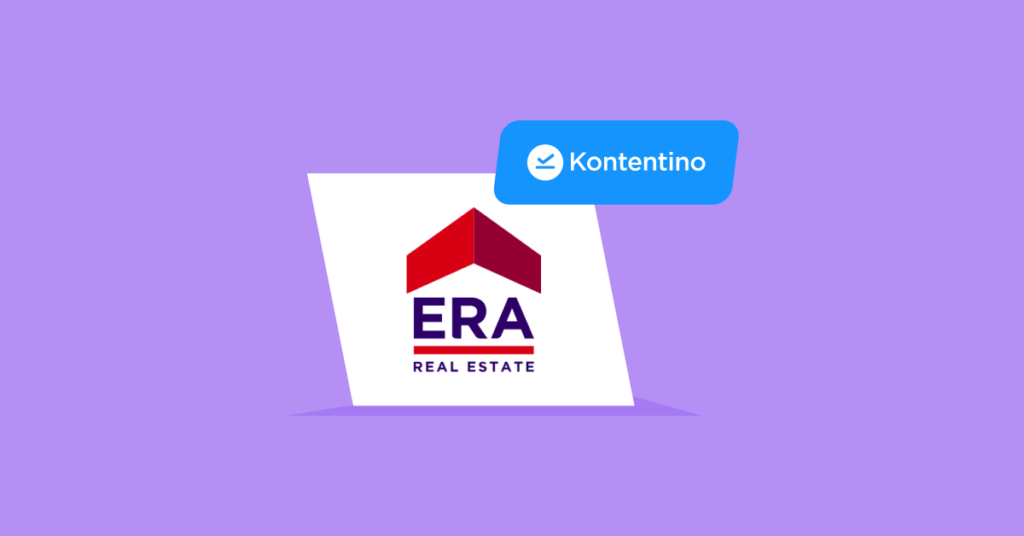
A thing to note regarding this case study is how Kontentino not only highlighted the impressive data but also how the product helped solve a core pain point for ERA Belgium’s franchises .
Highlighted in the middle of the case study is a bold quote from the client that helps solidify Kontentino’s KontentBase product as a must-have tool for franchises. When creating your own case study, consider your product and who’s needs it addresses. Align your customer quotes and data and results reports to match exactly what your target audience is looking for.
The Konetino case study also includes a CTA at the end so any potential prospects could directly contact the support team.
2. “How an SEO Agency Helped an Artisan Bakery Increase Organic Traffic by 214%,” is a very well written case study by Semrush

This comprehensive case study by Semrush is a perfect example of pinpoint narrative structure and proper formatting. The study flows like a well-written story and guides the reader through the subjects, conflicts and resolutions without a hitch. The tasteful addition of dashboards and bullet points ties the case study up perfectly.
3. “How Good Dye Young Increased Their Monthly E-commerce Revenue by 305%,” an impressive storytelling case study by Mailchimp
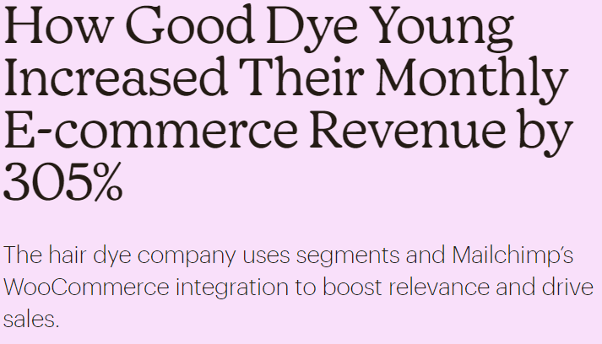
This case study by MailChimp is full of personality and storytelling. While MailChimp did include impressive numbers, the centerpiece of this case study is the people. The subjects in the case study are referenced casually by their first names, their journey is explored in-depth and there’s no shortage of quotes from them. The imaging MailChimp uses only emphasizes the human side of the relationship between them and the customer.
Keeping you on track with your social media case study
So now you’ve got a solid idea of what a comprehensive case study should include and you’ve seen the techniques we’ve covered in action. Now it’s time to go over a full template to ensure you stay on track when creating your awesome social media case study.
Social media marketing case study template
Outline: Case Study Title
Customer: Customer’s full name
Company: Company’s name
Industry: The industry the customer operates in (if applicable)
Video: Link to a video version (if applicable)
Author: Author’s name
Case study title
A short introduction of the customer.
Be sure to highlight:
- The customer’s name and a little bit about them.
- Why you and your customer were a perfect fit
- The key successes your customer had after working with you
Introduce your customer
In this section, provide a more in-depth overview of your customer. If it’s an individual, explain the person’s background in the context of your product/service. If it’s a business, talk about the company’s background, industry and any recent successes or milestones they have had.
Describe the problem
Explain the challenge or opportunity your customer faced before they did business with you. This could be either a reactive reason (i.e. the customer had an issue that needed to be addressed) or a proactive reason (i.e. there was an untapped potential that was unleashed by working with your business).
Why (Customer Name) Chose (Your Company)
In this section, speak about the decision process of your customer. Speak about how they discovered you, your possible competition and what made them ultimately decide to do business with you.
How (Your Company) Responded
Here, explain what happened once your business started working with your customer. What was addressed first, and why? How did your customer feel about working with you in the early days?
The Results
In closing, speak to the results your customer saw after working with you. This section can be supported by statements, quotes, visuals, graphs, and metrics. Whatever you decide to include, be sure it illustrates how much of an impact your company made on your customer.
Call-to-Action
Use this section to move your readers down the funnel. Add a CTA that encourages readers to either join your newsletter or get in touch with your sales team.
Related articles

How to Collaborate with Your Employees to Enhance Your Content Strategy

13 of the Best Sprout Social Alternatives for 2024

10 Must-Try CoSchedule Alternatives for Your Business

837k+ scheduled posts in the past year by users just like you.
OST – B2B Social Media Agency
A Leading Global B2B Social Media Agency
- Meet our Team
- Join our Team
- Corporate Social Responsibility
B2B Influencer Marketing
- Campaigns & Content
Social Strategy
Paid Social Advertising
- Global B2B Social Media
Community Management
Creative Studio
Social Executive Communications
- Event Activation
- B2B Lead Generation
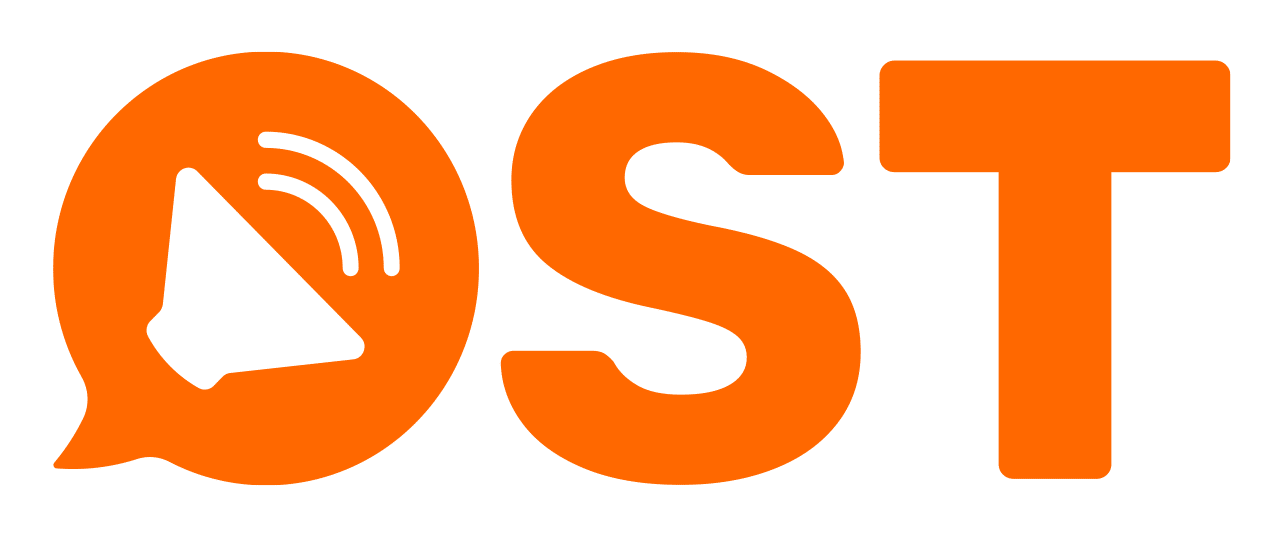
5 outstanding social media marketing case studies
Do you read social media marketing case studies for inspiration? It’s always a good idea to benchmark against your competitors or pinch ideas from them, but it’s also worth looking at success stories from the biggest brands out there. You might not have their budget, but you can always gain inspiration from their campaigns.
Here are five of the best brands on social and what I think you can learn from them:
1.Mercedes Benz – Repeated, successful social media marketing campaigns
Mercedes Benz seem to win every time with their social media campaigns. The one that stands out to me was back in 2013 when they created what I still believe to be one of the best Instagram marketing campaigns to date. Mercedes wanted to reach out to the younger audience so they hired five top Instagram photographers to each take the wheel of a new Mercedes CLA. Whoever got the most likes got to keep the car – so they all really worked at it!
By the end of the campaign, Mercedes has received:
- 87,000,000 organic Instagram impressions
- 2,000,000 Instagram likes
- 150 new marketing assets (stunning photos)
What lessons can you learn from this? Could you put your followers up for a challenge and make it into a competition or campaign?
- Can you do a competition that gets people trying out your product first?
- Think about your target audience. What is a prize they would value?
- Like Mercedes you could recruit bloggers/influencers via social media and get them blogging about your service or product. Whoever receives the most engagement wins .
2. Dove – Connecting with their target audience
Is it just me or do all the Dove marketing campaigns make you cry? If you’ve seen their Real Beauty sketches campaign, you’ll know what I’m talking about. Dove’s goal is to make women feel good about themselves. They know their target market and create content that tells a story that women can relate to.
Today I am… pic.twitter.com/VoAf2wRdwa — Dove UK & Ireland (@DoveUK) February 19, 2016
Dove did some research and found that 80 percent of women came across negative chatter on social media. Dove’s goal was to change that and make social media a more positive experience. As a result, Dove teamed up with Twitter and built a tool to launch the #SpeakBeautiful Effect, that breaks down which body- related words people use the most and when negative chatter appears during the day.
According to Dove, women were inspired by their message.
- #SpeakBeautiful was used more than 168,000 times
- Drove 800 million social media impressions of the campaign
Dove know their audience. Knowing your audience is the only way you will engage with them. The best way for this is creating personas. Knowing what life stage they are in, if they’re employed, what their interests are etc. will certainly help you when creating content. Then think about linking your audience to your brand values in order to create something just as successful as Dove’s campaign.
3. Nutella – Incredible content that makes you salivate
Each post makes you want to eat Nutella. There are a lot of people (including me) who take photos of their food before they eat it. Nutella does the same and it works. Nutella isn’t afraid to be fun and creative with different ingredients. Nutella is just a chocolate spread yet they manage to have fun with it. Do you, or could you, have a bit more fun with your brand?
Here are some ideas for having fun with your brand:
- Are you on different social media channels? If you’re B2B you might not think that Instagram is for you, but it can be a great way to demonstrate your brand values by telling a story. Fedex is a great example of this, showing images of their trucks always on the move. This tells a story that they are always delivering and that is the key message we take away.
- Key influencers/bloggers can be a great way to different types of content and to see how they have fun with your brand (if this is new to you, read our post on the rise of the social media influencer ).
- Instead of posting behind-the-scenes photos at your head office, can you encourage your followers to share their experiences with your brand? Maybe host an event or go out and meet them.
Take your #breakfast bread pudding to the next level with #Nutella ! 😉 pic.twitter.com/k0ko5Nm9iX — Nutella (@NutellaGlobal) May 5, 2016
4. Oreo – Smart content planning and timely delivery
Oreo is another brand that is known for their creative social media marketing. They must have a big design team to produce their content, but it works! They are consistent with their branding and manage to catch onto real time events. We all remember when the lights went out at the Super Bowl and during the half hour blackout Oreo tweeted out:
Power out? No problem. pic.twitter.com/dnQ7pOgC — OREO Cookie (@Oreo) February 4, 2013
This was retweeted over 15,000 times. Are you thinking outside the box about your brand? Plan ahead for events coming up that you might be able to jump on to.
Do you plan your social media content out? If you’re in B2B and don’t currently create content read here for some B2B content marketing tips to help you get started, or check out our B2B marketing strategy tips ebook for 2021.
It’s always a good idea to prepare content ahead of time. If you can schedule content on a monthly basis – perfect, but if not bi-weekly is great. That way you can check what events are coming up and plan content around them. This gives you time for any ad hoc creative to be done, such as jumping on real-time events like the Oreo blackout example above.
5. Airbnb – Stunning imagery and UGC
What might look like a visual travel blog, Airbnb ’ s content attracts fans with their visually compelling posts. On Instagram, they post user-generated photos from its hosts and guests. The content embraces their new campaign of ‘Don’t just go there, Live there’ which is captured through real photography. Each post receives high engagement, between 3,000 and 14,000 Instagram likes.

This is a great example of thinking slightly outside the box. Airbnb is all about accommodation. They don’t just post images of the inside of people’s homes. Seeing the culture and images of places all over the world comes with the experience of where you stay and that’s what connects with people. Think about your brand: are you just posting about the product/ service itself? Why not tell your followers a story instead?
Thanks for reading. I hope by reading these five social media marketing case studies it has spiked some inspiration! If you need any help with your social media advertising , influencer marketing , or other aspects of your social media strategy, feel free to contact us .
Should you upgrade to a LinkedIn Premium Company Page?
What is the linkedin algorithm and why is it important, get in touch.
Fancy an informal chat about your social media? Email us and we’ll get straight back.

We are a multi-award-winning social media agency that provides high-quality social media, content marketing and social advertising services for a global client-base.
Our Services
Campaigns & Content
Global Social Media
Contact Info
Unit 7 Bennell Court West Street Comberton Cambridge CB23 7EN UK
Privacy Policy | Cookie Policy
- Lockstep Baseline
- Brand and Messaging
- Marketing Plans
- Business Strategies
- Value Propositions
- Predatory Marketing
- Testimonials
- History's Greatest Strategists
- Knowledge Nuggets
- Marketing Strategy
- Business Strategy
- Customer Centricity
- Institute of Change
- (02) 8030 8655
July 3, 2018
How to Successfully Launch a Product Online [with Case Studies]
)
Even Amazon‘s $685 billion market value couldn‘t save the Amazon Fire. Launching a product online takes a lot of work — and it‘s something that can elude even the largest companies in the world.
Amazon‘s Fire phone flopped so hard in 2014 that people barely remember it today, and that‘s even after the ecommerce company cut its cost from $200 to 99 cents. Amazon misunderstood and misinterpreted the industry it was trying to launch in — and they assumed that the weight of their brand was enough to carry their marketing strategy.
This proved to be a costly and lasting mistake; it‘s doubtful that Amazon is going to be jumping into the smartphone market any time in the near future.
Still, Amazon‘s blunder did a lot to teach marketing companies about the value of an online launch strategy. If your company is considering an online product launch, there‘s a lot you can learn from case studies and from existing product launch tactics.
Here‘s what you need to know.
Planning to grow your business? Download our marketing plan template 2.0 to get started.
4 Steps to a Great Product Launch

Every product, market, and demographic is different. Despite this, the steps to a great online product launch generally fit into a simple outline. Create a strategy, develop your tactics, launch your product, and avoid common mistakes.
1. Create a Strategy
Your strategy begins with discovering your target audience . For many businesses, this will lead to building out lists and creating unique and specific audiences. Email lists, social media lists, and mailing lists — all these so you can build a relationship with your prospective customer base.
Once you‘ve built your contacts, list, and audience, you can determine the most accurate and effective sales hooks. You will already have positioned yourself as a trusted authority through repeated contact and valuable content . From there, it‘s only a matter of building up the momentum that can be used for a launch.
It‘s a dirty secret that you can make quite a few mistakes as long as you have a solid, respectable following. Amazon may be a well-known name, but it‘s never been able to foster personal relationships with its customers. It‘s simply too massive.
Plus Amazon is not considered an authority on smartphones — and consequently wasn‘t considered to be trustworthy within that industry. All of these elements together led to a strategy that just didn‘t work, regardless of how much access Amazon had to its customer base.
2. Develop Your Tactics
So how do you build your authority with your customers? How do you get them excited for a product launch online?
You need to keep their attention throughout your marketing efforts and make sure they are still interested by the time you‘re ready to sell. This requires tactics.
- Tell your customers a story . Your customers need to connect with your business and your products on an emotional level. Telling your customers a narrative helps them understand the context of your brand, your products, and your services. It also helps them relate to your brand, rather than thinking of your brand as “just another company.”
- Offer your customers value. Perceived value is key. As your customers continue to engage with your product, you need to offer them something of value. Whether it‘s valuable content or a discount on an eventual product, giving your customers value shows them that you care. This is why stores frequently offer pre-order bonuses and early adopter discounts.
- Create events for your customers to participate in . An event excites customers and builds their sense of anticipation, encouraging them to further engage with your brand. Live streams have become a popular way to connect with customers on an inexpensive and organic level.
- Show your customers social evidence. Customers don‘t trust advertising very much these days. Showing your customers social evidence — through social media sharing and testimonials — builds your credibility. This will also build your social media accounts, which will benefit your company in the future.
- Interact with your customers . Don‘t just send messages out into the void. Connect with your customers on a personal level, especially through social media campaigns and email. Respond professionally and in a timely fashion to any messages your customers send; customer service starts before the purchase does.
These are all mental triggers that will encourage your customers to follow your brand. Once your product launches, you need to seek an actual commitment. This requires different strategies.
- Remember that the customer is always right . Throughout your campaign, you‘ll get a sense of what the market wants. Sell what your market wants — not what you want to sell them. This is a lesson learned by Amazon. Amazon wanted to sell phones, but customers didn‘t want another smartphone option.
- Modify your product offerings based on feedback . If your customers have suggestions, listen; they know what they want. The more of their boxes you can check, the more likely you are to sell your product.
From pre-launch to post-launch, it‘s these tactics that are going to see you through. You need to continually listen to your customer base, modify your offerings, and update your strategies as you go. This is the best way to reliably ensure that your product launch will be successful.
3. Define Your Launch Path
What is a launch path? There are many different types of product launches, depending on the product that you‘re selling and the type of company you have.
A well-established business is going to have a different launch path from a startup company. An entrepreneur will have a different launch path from a small business.
Your launch may consist of a new type of product or service that‘s already similar to your existing offerings. Alternatively, it may be a radically different type of product — something that the market has never seen before.
In ecommerce launch , you have the benefit of creating a lean launch. If you‘ve already established your customer base, you don’t need a significant amount of paid advertising. Instead, you need to do research on the products and services your customers are interested in. You need to talk directly to them regarding whether they are interested in new products, and you need to identify the best ways to deliver solutions to their current problems.
Ecommerce launch paths are streamlined and simplified. A significant portion of the advertising occurs through the internet and through content marketing . Once a customer base has been developed, your launch can happen within minutes. Making your products available online is a click of the button away — from there, you just need to keep selling.
4. Avoid the Common Pitfalls
Amazon‘s mistakes were obvious: they were selling a product that their customers weren‘t interested in. They hadn‘t done the market research required to determine what customers really wanted in a phone, and they were going up against a number of already established options.
Many mistakes that you can make are obvious, but others may be a little more subtle. Here are some of the most common pitfalls:
- Not having a list of interested customers . You don‘t need to start with a list, but you do need to end with one. Don‘t assume that because you don‘t have a list yet, you can‘t make one. As your customer list grows, it will also begin to grow faster.
- Failing to properly form and identify your product . As noted, the product that you want to sell isn‘t necessarily the product that you‘re going to end up selling. The early stages of your marketing will lead to refining and modifying your product.
- Not having an expert . An expert in smartphones and smartphone development could have helped Amazon. If you don‘t have an expert, you should acquire one as soon as possible — they will tell you what direction to move into.
- Trying to rely solely upon expertise . By the same token, just being an expert in something doesn‘t mean that you‘re also a marketer. You need to have digital marketing strategies and tactics on your arsenal before you begin your campaign.
Over time, your marketing strategies are going to become unique and refined. You will figure out the tactics that work best for your business and your audience. At the same time, you‘ll still need to do the appropriate research each time. It‘s relying upon prior knowledge — and avoiding additional data — that was the downfall of Amazon.
8 Online Techniques for Your Next Product Launch

As we‘ve discussed, a solid online product launch is really about the process. A rigorous process ultimately leads to positive results, even if the product or service you‘re selling diverges from what you initially intended to provide.
Here are proven strategies that you can apply to make your product launch a huge success.
1. Build Your Product Messaging
This is the mistake that Amazon made — they failed to properly build their product messaging. Amazon didn‘t have the expertise to truly break into the smartphone market, and consequently, they weren‘t able to provide any content of value to their customer base.
Building your product messaging over time is the best way to test the waters and ensure that your products will sell.
Read this article to learn how to create the perfect messaging for your product.
2. Promote It on Your Business Blog
When the webcomic and humour site the Oatmeal launched their card game product “ Exploding Kittens ,” they made a record-breaking $8.7 million .
This is despite the fact that they had never launched a card game before — and they were only seeking an initial investment of $10,000. Since then, they have continued to develop and release games with great success.
Their secret? They took advantage of their preexisting audience and listened to their audience when they told them what they wanted. The Oatmeal was already wildly successful and had a substantial contact list. Their audience was interested already in additional The Oatmeal products and would purchase a wide variety of merchandise purely through its connection with the art of the comics trip. All of these things gelled together to create an immensely successful campaign.
Read this article to discover the top reasons why a blog is a must-have for businesses.
3. Focus on Your Customers and Their Needs
Who will be using your product, and how will your product change your customer‘s life? The iPhone 8 learned this lesson in a dramatic fashion when it became the first new iPhone release not to garner long lines and a flurry of purchasing .
Apple was so set on creating a new iPhone; they didn‘t ask themselves what their customers really wanted and expected. They released a product that was uninspiring. Other than wireless charging, the iPhone 8 did very little to improve its user‘s lives. More so, customers were anticipating other features that they expected in new iterations of the phone — and consequently, they wanted to wait until they saw a better product.
Learn 4 tested ways to identify unmet customer needs.
4. Optimise Your Website and Your Customer Experience
MoviePass was an interesting online phenomenon. It was wildly successful but also known for haemorrhaging money and providing terrible customer service . MoviePass is a $9.99 monthly subscription service that lets users view as many movies as possible, but MoviePass didn‘t expect to be as successful as it was. In fact, so many users signed up that the site had to reduce its services, and its customer support (or lack thereof) has become a notable problem.
Learn why making optimisations to your website to be predictive and personal can boost your customer engagement.
5. Create Buzz on Crowdfunding Platforms
Crowdfunding has become one of the most popular ways to launch a product online. It makes sense: if there is interest in your product, your product will sell. If no one wants your product, then you‘ll know, without having to invest a lot of money. If you have a product or a service more than you have a company, a crowdfunding platform may be the ideal solution.
The previously mentioned Exploding Kittens card game was a crowdfunded game, but it‘s certainly not the only immensely successful crowdfunded project. The Pebble electronic watch was able to earn $10 million on Kickstarter, while the Ouya raised $8.5 million in less than a month .
6. Create a Remarkable Product Explainer Video
A product explainer video is a necessity when you‘re trying to sell a product or a service that‘s unusual. You may need to explain to your customers what your product does better than the competition or simply explain to them the problem that your product is meant to solve.
7. Reach Out to Your Existing Customers
Your existing customers are also your most loyal customers. They‘ve already shown themselves to be interested in your company and your brand; they are the most likely to be in your demographic and interested in your new products.
8. Offer Pre-Orders
One of the reasons crowdfunding is so valuable is because they essentially work as a pre-order service. A pre-order shows that your market is genuinely interested. Pre-orders also work to make sure that you have cash flow from the start, which helps in keeping your company agile.
These are the strategies that are most likely to lead to engagement, and many of them aren‘t extraordinarily difficult to implement. It‘s just a matter of taking the time.
Product Launch Case Studies
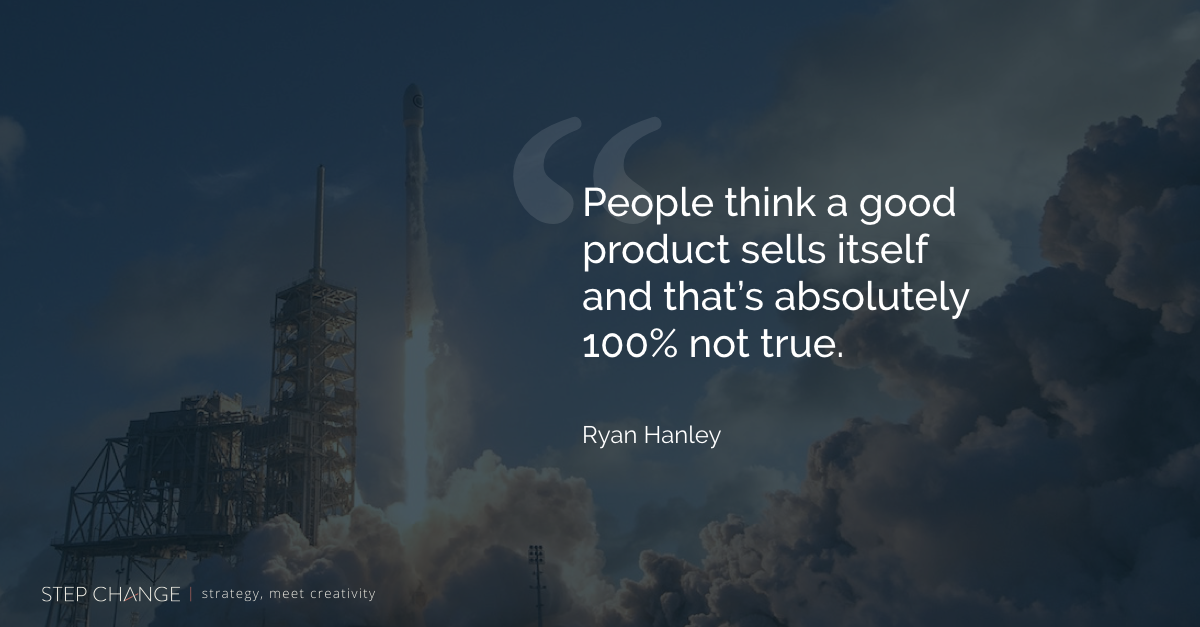
The best way to learn about product launches is to look at real product launches that occurred — which ones failed and which ones succeeded. The real world is extraordinarily different from the theoretical world.
Many failed product launches involve extremely large companies — companies that wouldn‘t be thought to make these types of mistakes.
Similarly, many of the most successful product launches are from relatively inexperienced companies — companies that just hit upon a need or drive within their demographic.
1. Gucci‘s “Fall Winter” Collection
Gucci launched its new product line in 2017 with a sequence of science-fiction inspired ads, which were meant to capture the attention of their audience. It worked because it was something that was unique and exciting to its user base. By creating a number of videos and images in the “Fall Winter” theme, Gucci was able to inspire creativity and interest in their followers.
2. Kate Spade Uses Live Streaming
Kate Spade was able to garner interest in its new collection through the use of live streaming — a technique which lets a brand talk directly to its most interested customers. Live streaming gives customers the opportunity to talk directly to the brand and to feel as though they are a part of an event that is bigger than themselves.
3. Barclay‘s Goes Mobile
When Barclay‘s launched its mobile app, Pingit, they discovered they were getting negative attention due to their 18 and older limitations. They reacted swiftly to correct this , leading to positive responses.
This is an example of modifying a product to suit your audience‘s needs. Barclay simply had not anticipated how many older teens were interested in using its services. The change was incredibly important as it opened up Barclay‘s to a totally different demographic.
4. Front App Uses Its Data
When Front launched its team management app , it was able to pare down through its data to find its top-performing advertising channels. Through this, they were able to improve upon their engagement and conversions. They focused on the advertising channels that worked best, and they were able to tailor their content to each successful channel.
5. Ben and Jerry‘s Leverages Its Social Media Marketing
When Ben and Jerry‘s launched its new products, it turned to its social media marketing. Ben and Jerry‘s sent out its core flavours to 210,000 Twitter followers and the 7.2 million followers on its Facebook pages . This was an affordable and easy way to send a message.
All of these successful product launches focused on putting their customers first. By putting their customers at the forefront, they were able to offer products that their customers want.
Amazon‘s failure to launch its smartphone may have been a win in other ways . Amazon was well-diversified enough that it was able to pivot successfully, moving into the area of smart home gadgets and away from cellular technology. And that‘s another important aspect to business: the ability to move in other directions.
Still, Amazon could have had a successful launch if they had better understood their market or if they had altered their product to suit their demographics. These are things that would have been avoidable but weren‘t simply because they underestimated the need for the appropriate strategy and tactics.
Ready to step up your marketing game? Download our marketing plan template 2.0 to get started!

Written by Step Change
We exist to inspire step changes in businesses and in people.
Tagged: Marketing Strategy , Digital , Business Growth
Comments (23)
- Marketing Strategy (198)
- Digital (107)
- Business Strategy (100)
- B2B Sales (68)
- Culture & Leadership (61)
- Branding (59)
- Step Change (59)
- Stump the Strategist (36)
- Ashton Bishop (35)
- Customer Centricity (25)
- Predatory Marketing (25)
- Content Marketing (23)
- Creativity (22)
- Business Growth (21)
- Disruption (18)
- History's Greatest Strategists (18)
- Knowledge Nuggets (16)
- Brand Archetypes (15)
- Finance (15)
- Decision Making (14)
- Power of Model Thinking (14)
- 2 Minutes On (12)
- Innovation (11)
- Challenger Brands (10)
- Powerful Presence (10)
- Technology (10)
- Marketing Automation (8)
- Artificial Intelligence (7)
- Better Insights (7)
- Better Questions (7)
- Norman Chorn (7)
- Popular Posts (7)
- Brand Positioning (6)
- Healthcare (6)
- Business Opportunities (5)
- Customer Journey (5)
- Fintech (5)
- Leadership (5)
- Productivity (5)
- underdog marketing (5)
- Aged Care (4)
- Alignment (4)
- Blue Print (4)
- Brand Building (4)
- Differentiation (4)
- Email Sales (4)
- High Performing Teams (4)
- Invisible Marketing (4)
- Marketing Technology (4)
- Referral Relationships (4)
- Success Principles (4)
- Transformation (4)
- Augmented Reality (3)
- Distinctive Brand (3)
- Ecommerce (3)
- Increase Sales (3)
- Personal Growth (3)
- Re-engage Database (3)
- Social Media (3)
- Software (3)
- Strategy Frameworks (3)
- Animation (2)
- Bendy Phones (2)
- Better World (2)
- Brand Saliency (2)
- Business Model (2)
- Construction (2)
- Conversion (2)
- Culture (2)
- Digital Economy (2)
- Digital Revolution (2)
- Domenico de Rosa (2)
- Email Marketing (2)
- Internet (2)
- Marketing Funnel (2)
- Measures That Matter (2)
- Not-for-Profits (2)
- Pharmaceutical (2)
- Power of Decision (2)
- Sales Strategy (2)
- Scenario Planning (2)
- Standing Out (2)
- Steve Jobs (2)
- Strategic Planning (2)
- Team Efficiency (2)
- The Big 6 Challenges (2)
- Thinking Routines (2)
- Virtual Reality (2)
- manifesto (2)
- 5G Wireless (1)
- AGL Smarter Working (1)
- Abercrombie & Fitch (1)
- Acquisition (1)
- COVID-19 (1)
- Cause-Related Marketing (1)
- Change Management (1)
- Comunet (1)
- Confirmation Bias (1)
- Dame Anita Roddick (1)
- Daniel Kahneman (1)
- Database (1)
- Dean Mannix (1)
- Digital Marketing (1)
- Disciplines (1)
- Distribution (1)
- Drone Racing (1)
- Dual Transformation (1)
- Elon Musk (1)
- Exclusive Interview (1)
- Execution (1)
- Exponential Organizations (1)
- Financial Services (1)
- Fisher Price (1)
- Fundamental Attribution Error (1)
- Gamblers Fallacy (1)
- Gorilla Glass (1)
- Growth Hacking (1)
- Hackers (1)
- Henry Ford (1)
- Hospitality (1)
- Ice Bucket Challenge (1)
- Ideation Process (1)
- Institute of Change (1)
- Ladder of Inference (1)
- Launching an App (1)
- Lean Principles (1)
- Lee Se-Dol (1)
- Mahatma Gandhi (1)
- Mark W. Johnson (1)
- Marshall Van Alstyne (1)
- Mcdonald's (1)
- Microsoft (1)
- Mission Statement (1)
- Newsreel (1)
- Online Streaming (1)
- Our Work (1)
- Pepper the Robot (1)
- Platform Revolution (1)
- Professional Services (1)
- Property (1)
- Range Architecture (1)
- Real Estate (1)
- Reality Distortion Field (1)
- Reporting (1)
- SalesITV (1)
- Salim Ismail (1)
- Sean Covey (1)
- Selling Persuasively (1)
- Smart Decision System (1)
- Smart Risk (1)
- Start-Up (1)
- Sustaining Change (1)
- The Body Shop (1)
- The Invoice Market (1)
- Thinking Models (1)
- Tracking (1)
- Unicorns (1)
- VUCA World (1)
- Value Proposition (1)
- Walter Isaacson (1)
- Warren Buffet (1)
- Water Jet Cutting (1)
- Wintergartan Marble Machine (1)
- Women in the Workplace (1)
- YouTube (1)
- Zoom Pavillion (1)
- alcohol (1)
- crowd sourcing (1)
- eLearning (1)
- eSports (1)
- exponential marketing (1)
- invisible communications (1)
- linkedin (1)
- thinking (1)
Related posts

Recent posts
To get to know you better, please fill in the field below..
Step Change, Unit A1/35 – 39 Bourke Rd,NSW 2015, Alexandria , Sydney, NSW, 2015 (02) 8030 8655

These 3 brands stuck the landing on their rebranding rollout. (Here’s how you can too)
Vladimir Kacar , Jo Clarke , Eli Greenspan
If you’ve made the pivotal decision to rebrand, you’ve likely spent months — perhaps even years — developing the strategy, conducting market research, and gaining buy-in from your leadership team. And you’ve probably engaged a branding agency to help you design a compelling visual identity that will crystallize your new brand promise in consumers’ and stakeholders’ minds.
But when it comes to introducing and rolling out your new brand into the world, your work has just begun. Now it’s time to determine which rebrand strategy will yield the right results based on your organization’s goals and objectives — and begin weighing all the details related to a successful rebranding implementation.
Whether you launch your rebrand with a big bang or slowly introduce your new identity over time, you’ll need a thorough and thoughtful implementation plan that will set your rebrand up for success.
To help you think through what’s possible — and to show you how BrandActive can help — we’ve curated three examples of brands who rolled out their rebrand in unique and memorable ways.
A big bang rebrand helped this global communications company smoothly launch a spin-off brand
When Siemens Enterprise Communications made the strategic decision to spin off from Siemens, the global German manufacturer, they knew they needed an entirely new name to distinguish themselves from their well-known legacy brand.
To ensure a successful outcome, spin-off Siemens engaged BrandActive to help plan an impressive social media-driven rebranding initiative that spanned 40 countries. In the months leading up to launch, teaser campaigns showcased colors from the new logo. Ads let stakeholders know something big was coming.
This lead-up culminated with a perfectly coordinated launch event based at the company’s headquarters in Munich. The simulcast event featured remarks from the CEO and a grand physical and digital unveiling of the company’s new name and visual identity. And by watching the webcast and joining the social media conversations, each location around the globe was able to celebrate together.
The launch was just the beginning. A complex trademark license agreement required that Unify convert all their branded assets — including vast quantities of hardware products and the service manuals and documentation that accompanied them — within one month of launch. This was no easy feat for a company that produces communication hardware used all around the world!
To support Unify in reaching their objectives, BrandActive:
- Helped create a realistic budget and find ways to fund it.
- Developed branded asset conversion strategies, processes, and documentation.
- Factored in the dependencies that existed among the many global offices and teams.
- Managed the vendors and agencies who were integral to planning and executing the launch.
Your takeaway? It’s possible to pull off a global rebranding initiative that makes a big impact with employees and customers. And with so many moving parts, an expert partner can help you make sense of the myriad factors involved and integrate them all into a cohesive action plan.
Rebrand roadmap - from development to implementation
This high-level infographic provides a look at the steps involved in your brand conversion from a brand implementation and development perspective. Learn what happens in what order during a typical rebrand so you can build your rebrand roadmap for success.
How a smart branded asset conversion strategy helped propel a household name into the modern era
Rebranding takes many forms. Sometimes it’s a full-fledged revolution, as was the case with Unify. On the other hand, sometimes it’s an evolution that illustrates where your brand is heading while building on the value and name recognition your brand has established over many decades.
That was the case for Verizon. When they embarked on a visual identity evolution in 2015, they did so to make their logo more relevant, modern, and reflective of the ways the company had grown and expanded over time. Their goal was to make their red check mark stand for itself, like Nike’s swoosh and Starbucks’ siren.
The biggest impediment to Verizon’s rebranding initiative was the enormous cost involved with converting their logo in hundreds of retail locations. Therefore, BrandActive helped Verizon’s marketing leadership team make the case for the value of the brand evolution through extensive financial modeling, smart planning, and creative branded asset conversion strategies.
Verizon introduced its new visual identity through targeted, consumer-facing advertising and media campaigns — kicking off with the first NFL game of the 2015 season. They converted sponsorships and other high-priority assets quickly in order to get the most ROI upfront as possible. Then, they replaced the majority of their branded assets (e.g. retail storefronts, Fios fleet vehicles) over a much longer time scale and multiple budget cycles.
Your takeaway? There are many ways to make the cost of a rebranding initiative more attainable. By focusing on the areas with the biggest ROI first, you can begin reaping the benefits of your brand’s new identity as you systematically convert your assets over a period of years.
Honoring the emotional connection to a legacy brand was key for this rebrand
When rebranding a health system, it’s important to keep a key factor in mind. A health system’s brand equity isn’t just about the monetary value of the brand. It’s about the emotional value as well. After all, hospitals are where the realities of life and death come into clear focus for so many of us.
Providence , a comprehensive health care organization made up of 52 hospitals and 1,000+ clinics located primarily on the West Coast of the U.S., rebranded with a firm understanding of the emotional complexities they faced. Their rebrand came as a result of merging two well-known health systems together. Each legacy brand brought its own heritage, patient base, and brand equity to the merger. Therefore, the rebrand implementation strategy focused on communicating thoughtfully with the 120,000 employees (known as caregivers) and community members who cared deeply about each brand.
Helping caregivers let go of the legacy brand
Providence went to great lengths to honor the legacy brand and help caregivers let go of the name they loved. As a historically Catholic organization, they incorporated prayer cards and blessing ceremonies into their rebranding strategy. When signs were taken down from buildings, caregivers were invited to witness the process, reflect, and let go of that physical representation of the brand.
Additionally, at a select few locations, caregivers received their new ID badges, and were encouraged to take a piece of rice paper, write a prayer, thought, or memory on it, and then drop it into water where it would dissolve. This served as a tangible and meaningful symbol of change.
Inviting community members to embrace the new brand
A key part of Providence’s rebranding strategy was to time the external launch with fall open enrollment. That way community members could experience the new brand in a cohesive manner while enrolling for their benefits and services. To promote open enrollment, Providence developed a media campaign that showcased time-lapsed drone footage of new signage being installed at several hospital locations.
BrandActive helped Providence with all elements of the planning process, including replacing a few key signs that could be expedited through internal and external review processes more quickly. This enabled Providence to meet their launch deadline and make an impact with their members. Like Verizon, they then continued converting the remaining branded assets over a longer period of time.
Your takeaway? When rebranding, know your audience. If your stakeholders have an emotional connection to your legacy brand, find meaningful ways to help your audience let go so they can wholeheartedly embrace your new brand.
Are you ready to rebrand?
What will your rebranding launch and implementation look like? It’s up to you. There’s no right way to approach your rebrand — but in order to pull your good ideas off without a hitch, you need the right partner by your side.
We’d love to help you think through your launch strategy, create a detailed asset conversion plan, develop a realistic budget, and integrate your agency partners and vendors toward a common goal. We can take you from start to finish and make the process as memorable and enjoyable as possible.
Whenever you’re ready to get started, we’re ready to help .
Related Insights

Which rebranding launch strategy is best for your brand’s next chapter? 4 core elements to point you in the right direction

Planning for rebranding implementation

How do you rebrand all your branded assets? Here are 4 unique examples to inspire you
The Beauty Brand Launch Campaign: A How-To
A Model for a Modern Fragrance Launch, Sans Célébrité
The context
Beauty brand launch campaigns have done it all: inspired , they’ve provoked , even demeaned and put Giselle Bündchen on a surfboard .
In this era of rampant retail disintermediation and DTC, the beauty brand launch environment has never been more saturated.
In the past 5 years, the number of beauty brand launches has skyrocketed. So, too, have budgets for launch, thanks to a burst of beauty-focused private equity and venture capital funding . And then there are the celebrities. As Allure Magazine put it in 2021: “If it’s a day of the week ending in Y, a celebrity is probably launching a skin-care or makeup line.”
This page analyses our strategy for the game-changing global fragrance launch for Guerlain’s Le Petite Robe Noir. This case study is put in context of both standard beauty brand launch convention/formula, as well as the changes happening in the beauty market as we look to 2023. This page gives key insights for anyone planning beauty brand marketing at a time when brands can no longer afford to follow formula.
So what, exactly, is the beauty brand launch campaign formula?
The Formula
Beauty brand launch campaigns tend to follow a 3-part formula:
Beauty and fragrance consumer marketing campaigns overwhelmingly have a “face” – a celebrity or model demonstrating the product’s promised outcome, and semiotically, the product’s intended audience. The inherent challenge is that, like beauty or fame itself, brand equity can fade when it’s tied to celebrity endorsement deals that can, over time, run their course.
2. “Factice”
Factice refers to the giant bottles of perfume seen at department and duty free stores. Historically, the classic beauty brand launch begins with shelf space at standard-bearer retailers or “beauty counters.” If a beauty brand is new, the illusion of “exclusive” distribution at a single retailer can suffice until the brand is proven, or to maintain exclusivity.
In a new era of beauty brand launch campaign strategy, the concept of “factice” might be swapped – to maintain alliteration – with the customer “Funnel”. Essentially: how will the brand connect with customers to drive sales? Even in the early-DTC era of Cher and Christy Brinkley selling beauty products on Home Shopping Network and QVC, “Funnel” involved the viewing audience and those station’s backend capabilities for distribution and fulfilling sales. This is a piece of beauty launch that is changing rapidly in light of advancements of performance media making retailers an additive – but no longer essential – part of the beauty space.
3. Frequency
Finally, frequency is the final and arguably most important step. Frequency generally refers to the number of times an individual sees an ad. For beauty, frequency is everything. It takes repetition to make the point that a product is a necessity. Worth the investment. The epitome of cool. A brand that “gets you.” And that a specific brand’s product can make you as desirable as the Face it’s associated with. In sum: Frequency is the pivotal part of the beauty brand launch campaign that establishes the brand as desirable and drives urgency to purchase.
Case Study: Context
When a 180 year-old French fragrance house approached us with a new fragrance, they came prepared to re-write the beauty brand launch formula.
Our client was set on launching a new, global product aimed at a younger consumer. And importantly, they sought to omit a classic advertising centerpiece: the “hook” of the celebrity endorsement.
This decision influenced the campaign’s creative look and feel. It demanded a novel approach to paid media strategy and frequency, given the global nature of the product and aggressive sales goals. Key details of this highly-confidential brand launch campaign:
- Face: Campaign creative was developed by the client in-house, intentionally sans célébrité .
- Factice: Global consumer-facing launch at all key fragrance points of sale, with special emphasis on airport retail and in-flight, duty free, which carry measurement challenges.
- Frequency: Media strategy was marked by a desire to use nontraditional media.
Celeb Beauty Brand Boom
As mentioned before, our launch came at the dawn of a boom in beauty brands backed by celebrities. While celebrity beauty brands aren’t necessarily new, there are four key reasons why we’re seeing so many new beauty brand launches:
- Firstly, beauty, as a category (including, and especially, fragrance) has fabulously high product margins. It’s profitable.
- Next, beauty brands are (relatively) easy to launch. With the proliferation of white-label factory operations and drop shipping, beauty products are easy to create and produce.
- Third, social media creates the illusion of easy access to mass exposure. Whether you’re a celebrity with millions of followers or an VC-backed brand manager looking to buy exposure, social platforms promise easily-accessible reach. But whether they can deliver at a reasonable CAC is dependent on a final factor: funding.
- Finally, and perhaps most importantly: global venture capital funding is on a spree, soaring to all time highs. The value of global deal flows is nearly double what they were in 2016, and 5x what they were in 2012. This means, for new beauty brand launches (and other startups), there is more money being deployed for startups than ever before.

Why does this matter to celebrity beauty brand launches, and the beauty industry at large?
By our internal estimates, the increase in celebrity-backed beauty brand launches specifically has accelerated competition for share of voice by as much as +30% over the past 5 years on certain media channels, given the size of their organic audience and formula for paid media deployment of VC funding.
Here’s a brief history in beauty brands with stars holding beauty brand equity interest:
Iman , Makeup for Women of Color, Iman.
Meaningful Beauty, Cindy Crawford. Living Proof (hair), Jennifer Aniston (acq., Unilever in 2016).
Josie Maran Cosmetics, Josie Maran.
Kora Cosmetics, Miranda Kerr.
Honest Company, Jessica Alba. (IPO in 2016)
Flower Beauty, Drew Barrymore.
MDNA, Madonna (US launch 2019). Kylie Cosmetics , Kylie + Kris Jenner, backed by Seed Beauty.
goop skincare, Gwyneth Paltrow. (goop launched 2008, skincare arrived 2016).
Fenty, Rhianna.KKW Beauty, Kim Kardashian, 2017 – 2020.
ProDNA (skin), Paris Hilton. Hilton has launched 25 fragrances.House 99 (men’s grooming), David Beckham.
Haus Laboratories, Lady Gaga. (“This is not just another beauty brand.” Per Haus .)Victoria Beckham Beauty, Victoria Beckham.Henry Rose (fragrances), Michelle Pheiffer.
Fenty Skin, Rhianna.Rare Beauty, Selena Gomez.Keys Soulcare, Alicia Keys, collab with E.L.F. Humanrace (skin), Pharrel Williams.Biossance, Reese Witherspoon: a 5-year deal rumored to involve equity.
JLo Beauty, Jennifer Lopez.nomaly (hair), Priyanka Chopra Jones.Know Beauty, Madison Beer and Vanessa Hudgens.Treslúce Beauty, Becky G.About-Face, Halsey.Proudly, Gabrielle Union-Wade and Dwayne Wade. Bardi Beauty, Cardi B (USPTO Filing April, 2021).Kris Jenner Beauty (USPTO filing, Feb 2021).“SKNN,” Kim Kardashian (USPTO filing, March 2021).
Rose, Inc., Rosie Huntington-Whiteley.R.E.M., Ariana Grande.Rhode (skin), Hailey Bieber.Brand Name TBD, Harry Styles .Brand Name TBD, Scarlett Johansson. Johansson is known for repping L’oreal Paris and Dolce & Gabbana’s “The One” Fragrance.LolaVie, Jennifer Aniston (USPTO filing 2019), rumoured launch 2022.
Never to be outdone, Kim K has now launched her own Private Equity fund with ex-Carlyle partners. Suffice to say: celebrities are no longer walk-on, walk-off spokesmodels. They want cold, hard equity.So what does this mean for ambitious brand launches (particularly those lacking a celeb face)? Read on to find out.
"How-to" + Insights
So how should smart brands execute a beauty brand launch campaign? Let’s revisit the 3-part beauty brand launch formula with a lens toward specific opportunities for disruption:
Obviously, if you represent a celebrity beauty brand, this piece is a given. But for brands focused on a different angle, consider: who or what gives your brand voice ? Differentiation is par for the course. Consider a “wish list” for casting and define what, precisely, makes your product essential to a specific customer. From a more tactical perspective, two points to note:
- Creative used for multinational brand launches generally avoid spoken-word monologue, to avoid the awkwardness of re-dubbing for new languages. A well-done animated character, if brand-appropriate, can demonstrate brand character without the challenges of cross-market casting.
- There’s no need to select a single “face” now. A chorus of well-chosen influencers can provide “brand voice” and brand visibility simultaneously. Key to influencer-led strategies is coordination. More on this in the next point.
Consider your points of sale and distribution. And don’t be narrow-mindedly digital. Shopify and Amazon make sales and distribution a possibility overnight. But the value of shelf-space in retail cannot be under-stated. (It’s even brought well-funded, highly-regarded startups to their knees with unexpected demand). Points to consider:
- Duty free shopping environments are among the best in the world for beauty brand sales. They are also a battlefield for shelf-space as well as ad-space. More on this below.
- If you’re selling online and in-store (congratulations!), measuring both channels can be complex. And consumer product sales measurement traditionally used by CPG brands don’t measure multinational sales in specialized environments well. Either way, it may be necessary to innovate in establishing KPIs to measure successful outcomes, particularly in the short-term launch timeframe.
Finally, all launch campaigns – beauty or otherwise – are limited by budget. Inherently. To master your efficiency out of the gate, you need to be creative in achieving frequency. Key points:
- Timing. Is. Everything. Launch media – both paid, owned, and earned, must be intricately orchestrated and timed to push to maximize buzz. Budgets for a beauty brand launch campaign – particularly one with global ambitions – will never be large enough to sacrifice smart planning.
- In the case shared here, launch was “phased” market-by-market, focusing on high-visibility events to create maximum frequency for a jetset traveler audience who, in the client’s estimation, was a prototypical fashion editor jumping from fashion week to fashion week…
- Media planning and buying targeting traveler markets must be multi-pronged, visible and innovative, but success is truly dependent on strategic merchandising at point of sale, particularly for products as trial-based and experiential as fragrance.
The Beauty Brand Launch Solution, For Fragrance
Consumer care brands, and fragrance in particular, need frequency. Yet captivating an audience of transient, jetset global travellers in heavily-saturated Duty-Free retail environments isn’t easy. Thinking beyond “fragrance formula” marketing opportunities heavy on print and TV, we turned to experiential marketing and traveler media such as taxi TV to encapsulate our audience using robust animated video assets.
In all, our high-impact consumer marketing tactics “encapsulated” the international traveller in airport, inflight, and key live activations. Just weeks into the launch, the scent’s Parisian-inspired animated figurine would be ubiquitous to its target market of jetset international travelers seeking a signature scent. And word travelled quickly.
Case Results
Just three months after the fragrance’s international launch, sales topped one million units sold. By end of launch year, the fragrance ranked No. 2 in women’s fragrance sales in the brand’s home market.
In addition, the fragrance’s launch campaign creative received honours including Best Global Advertising (Grand Prix Stratégies), a Marie-Clare Audacity Award, Best Advertising Film (Fifi Awards UK), etc. And, in the ultimate proof of the brand’s commercial success, this single scent launched a range of 10 (and counting!) fragrance “ flankers ” – one of which won a FiFi award for Best Feminine Fragrance, along with a colour cosmetics range, and collaborations with a French sportswear apparel brand and American leather apparel maker.
Readings / Resources:
- Economist, Continental Drift: Duty-free retail is finding new ways to grow .
- Reuters, Global venture capital investments hit record high .
Marketing case study 101 (plus tips, examples, and templates)

Summary/Overview
If you’re familiar with content lines like, “See how our fancy new app saved Sarah 10 hours a week doing payroll,” you’ve encountered a marketing case study. That’s because case studies are one of the most powerful marketing tools, showcasing real-world applications and customer success stories that help build trust with potential customers.
More than 42% of marketers use case studies in their marketing strategy. Let’s face it — we love testimonials and reviews. People love hearing customer stories and experiences firsthand. In fact, 88% of consumers view reviews before making a purchase decision. Case studies work similarly by providing prospective customers with real-life stories demonstrating the brand’s success.
Case studies provide a more in-depth view of how your product solves an existing problem — something potential buyers can relate to and learn from.
In this article, we take a closer look at what marketing case studies are, why they’re important, and how you can use them to improve your content marketing efforts. You’ll also learn the key elements of a successful case study and how to turn a good case study into a great case study.
What is a marketing case study?
A case study is a narrative that documents a real-world situation or example. A marketing case study is a detailed examination and analysis of a specific strategy, initiative, or marketing campaign that a business has implemented. It’s intended to serve as an all-inclusive narrative that documents a real-world business situation and its outcome.
Marketing case studies are tools businesses use to showcase the effectiveness of a particular tool, technique, or service by using a real-world example. Companies often use case studies as sales collateral on websites, email marketing, social media , and other marketing materials. They provide readers with a firsthand look into how your product or service has helped someone else and demonstrate the value of your offering while building trust with potential customers.
Some common key components of a marketing case study include:
- Context: A case study begins by describing the business’s situation or problem. This often includes challenges, opportunities, or objectives.
- Strategy: An outline of the tactics or strategy utilized to address the business’s situation. This includes details such as the target audience, messaging, channels used, and other unique aspects of the approach.
- Implementation: Provide information about how the strategy was implemented, including timeline, resources, and budget.
- Results: This is arguably the most crucial part of a marketing case study. Present the results through data, metrics, and key performance indicators (KPIs) to demonstrate the impact of the strategy. The results section should highlight both qualitative and quantitative data.
- Challenges and Solutions: A great case study not only focuses on the successes but addresses any obstacles faced during the campaign. Make sure to address any challenges and how they were overcome or mitigated.
- Customer Feedback: Including testimonials or quotes from satisfied clients is a great way to add credibility and authenticity to a case study. Choose customer feedback that reinforces the positive outcomes of the strategy taken.
- Visuals: Compelling case studies include visuals such as graphs, charts, images, videos, and infographics to make the information presented more engaging and easier to understand.
- Analysis: An optional way to conclude a case study includes discussing key takeaways, insights, and lessons learned from a campaign.
Case studies can help you connect your product to the customer’s needs by providing a real world examples of success and encouraging conversions.
Benefits of marketing case studies
Some of the key benefits of using case studies in your marketing efforts include the following:
- Building trust and credibility. You build trust and credibility with potential clients or customers by demonstrating real world success stories. In-depth looks at how your products or services have helped other businesses or people achieve success can increase customer loyalty and encourage repeat business.
- Learn best practices. Learn from strategies employed in successful case studies and apply similar approaches to future campaigns.
- Enhancing sales and conversions. By highlighting the real world results your products or services have delivered, case studies can be a powerful tool for boosting sales. They can help demonstrate the value of your offering and persuade your target audience to make a purchase.
- Explain how your business generates results. Case studies are a compelling way to share key takeaways with your target audience and showcase your brand.
- Use them as content marketing material. Use case studies as content for marketing purposes on websites, social media, and beyond.
Case studies can help your business stand out and achieve success. By highlighting the real world results you’ve delivered, you can use case studies to boost sales, build customer loyalty, and compellingly showcase your business.
Tips on how to write an effective marketing case study
Are you ready to write a compelling case study? Get started with these tips.

Develop a clear and compelling headline
You have about 10 seconds to communicate your value proposition to keep customer attention. Whether you’re designing a new landing page or making a long-term plan for your brand’s content marketing strategy , the headline is the most crucial part.
A compelling title should capture readers’ attention and make them want to read more. To craft a compelling headline:
- Understand your audience: Before crafting a headline, ensure you know your target audience — what are their pain points, interests, and needs?
- Highlight the most significant result: Focus on the most impactful result achieved in the case study. What was the primary outcome of the strategy implemented?
- Keep it brief: Keep your headline concise and to the point. Try to keep your headline under 12 words.
- Use action words: Incorporate action verbs such as “achieved,” “transformed,” or “boosted” to convey a sense of accomplishment.
- Include data: Numbers make your headline more credible. For example, if the case study achieved a 75% increase in sales, include that in the headline.
- Emphasize benefits: Focus on the positive changes or advantages the implemented strategy brought to the client or business. Use these as selling points in your headline.
- Make it unique and memorable: Avoid generic phrases to make your headline stand out from the competition.
- Use keywords wisely: Incorporate relevant keywords that align with the case study and your target audience’s search interest to improve search engine visibility through search engine optimization (SEO).
- Consider subheadings: If you cannot fit all the necessary information in a headline, consider adding a subheading to provide additional context or details.
Here are some examples of clear and convincing case study headlines:
- “Achieving a 150% ROI: How [XYZ] Strategy Transformed a Startup”
- “How Optimized SEO Tactics Skyrocketed Sales by 80%”
- “Mastering Social Media: How [ABC] Brand Increased Engagement by 50%”
- “The Power of Personalization: How Tailored Content Quadrupled Conversions”
Write relatable content
Almost 90% of Gen Z and millennial shoppers prefer influencers who they consider relatable. Relatability is part of building trust and connection with your target audience.
When writing your case study, make content that resonates with readers and speaks to their pain points. The best marketing doesn’t just increase conversion rates — it also serves your customers’ needs. To write content that really resonates with your target audience, make sure to:
- Understand your audience: To successfully write relatable content, you first need to understand your target audience — their interests, pain points, and challenges. The more you know about your target audience, the better you can tailor your content to their needs.
- Identify pain points: As mentioned above, identify challenges your target audience may face. Make sure to highlight how the product or service in the case study can effectively address these pain points.
- Tell a story: Create a narrative that follows a standard story arc. Start with a relatable struggle that the customer or business faced and describe its associated emotions.
- Use real customer feedback: Incorporate quotes or testimonials from actual customers or clients. Including authentic voices makes the content more relatable to readers because they can see real people expressing their experiences.
- Use relatable language: Write in a tone to which your audience can relate. Only include overly technical terms if your target audience solely consists of experts who would understand them.
- Use social proof: Mention any recognitions, awards, or industry acknowledgments that may have been received by the customer or business in the case study.
- Encourage engagement: Urge readers to share their own challenges or experiences related to the subject matter of the case study. This is a great way to foster a sense of community.
Outline your strategies with corresponding statistics
Whether you’re showing off the results your marketing team achieved with a new strategy or explaining how your product has helped customers, data and research make it easier to back up claims.
Include relevant statistics in your case study to provide evidence of the effectiveness of your strategies, such as:
- Quantitative data: Use numerical data to quantify results.
- Qualitative data: Use qualitative data, such as customer testimonials, to back up numerical results.
- Comparisons: Compare the post-campaign results with the pre-campaign benchmarks to provide context for the data.
- Case study metrics: Include specific metrics relevant to your industry or campaign if applicable. For example, in e-commerce, common metrics could include customer acquisition cost, average order value, or cart abandonment rate.
By incorporating relatable outcomes — such as cost savings from new automation or customer responsiveness from your new social media marketing campaign — you can provide concrete evidence of how your product or service has helped others in similar situations.
Use multiple formats of representation
People love visuals . It doesn’t matter if it’s an infographic for digital marketing or a graph chart in print materials — we love to see our data and results represented in visuals that are easy to understand. Additionally, including multiple representation formats is a great way to increase accessibility and enhance clarity.
When making a case study, consider including various forms of representation, such as:
- Infographics: Use infographics to condense critical information into a visually appealing, easy-to-understand graphic. Infographics are highly sharable and can be used across marketing channels.
- Charts: Use charts (bar charts, pie charts, line graphs, etc.) to illustrate statistical information such as data trends or comparisons. Make sure to include clear labels and titles for each chart.
- Images: Include relevant photos to enhance the storytelling aspect of your case study. Consider including “before and after” pictures if relevant to your case study.
- Videos: Short videos summarizing a case study’s main points are great for sharing across social media or embedding into your case study.
- Tables: Use tables to help organize data and make it easier for readers to digest.
- Data visualizations: Include data visualizations such as flowcharts or heatmaps to illustrate user journeys or specific processes.
- Screenshots: If your case study involves digital products, include screenshots to provide a visual walkthrough of how the product or service works.
- Diagrams: Use diagrams, such as a flowchart, to explain complex processes, decision trees, or workflows to simplify complicated information.
- Timelines: If your case study involves a timeline of specific events, present it using a timeline graphic.
Use a consistent design style and color scheme to maintain cohesion when incorporating multiple formats. Remember that each format you use should serve a specific purpose in engaging the reader and conveying information.
Get your case study in front of your intended audience
What good is a compelling case study and a killer call to action (CTA) if no one sees it? Once you’ve completed your case study, share it across the appropriate channels and networks your target audience frequents and incorporate it into your content strategy to increase visibility and reach. To get your case study noticed:
- Take advantage of your website. Create a dedicated section or landing page on your website for your case study. If your website has a blog section, consider including it here. Optimize the page for search engines (SEO) by including relevant keywords and optimizing the meta description and headers. Make sure to feature your case study on your homepage and relevant product or service pages.
- Launch email marketing campaigns. Send out the case study to your email subscriber list. Be specific and target groups that would most likely be interested in the case study.
- Launch social media campaigns. Share your case study on your social media platforms. Use eye-catching graphics and engaging captions to draw in potential readers. Consider creating teaser videos or graphics to generate interest.
- Utilize paid promotions. Use targeted social media and search engine ads to reach specific demographics or interests. Consider retargeting ads to re-engage visitors who have previously interacted with your website.
- Issue a press release. If your case study results in a significant industry impact, consider issuing a press release to share the exciting news with relevant media outlets or publications.
- Utilize influencer outreach. Collaborate with influencers who can share your case study with their followers to increase credibility and expand your reach.
- Host webinars and presentations. Discuss the case study findings and insights through webinars or presentations. Promote these events through your various marketing channels and make sure to encourage participation.
- Utilize networking events and conferences. Present your case study at industry-related conferences, trade shows, or networking events. Consider distributing printed or digital copies of the case study to attendees.
- Utilize online communities. Share the case study in relevant online forums and discussion groups where your target audience congregates.
- Practice search engine optimization (SEO). Optimize the SEO elements of your case study to improve organic search ranking and visibility.
Remember, the key to successfully promoting your case study is to tailor your approach to your specific target audience and their preferences. Consistently promoting your case study across multiple channels increases your chances of it reaching your intended audience.
Marketing case study examples
Let’s look at some successful marketing case studies for inspiration.
“How Handled Scaled from Zero to 121 Locations with HubSpot”

Right away, they lead with compelling metrics — the numbers don’t lie. They use two different formats: a well-made video accompanied by well-written text.
The study also addresses customer pain points, like meeting a higher demand during the pandemic.
“How AppSumo grew organic traffic 843% and revenue from organic traffic 340%”

This case study from Omniscient Digital leads with motivating stats, a glowing review sharing a real user experience, and a video review from the AppSumo Head of Content.
The case study information is broken down into clearly marked sections, explaining the benefits to their target audience (startups) and providing plenty of visuals, charts, and metrics to back it up.
“How One Ecommerce Business Solved the Omnichannel Challenge with Bitly Campaigns”

Download this Bitly case study from their site to see the details of how this company made an impact.
Not only is it well designed, but it also tackles customer challenges right away. The most compelling types of case studies serve their audience by showing how the product or service solves their problems.
Bitly nails it by listing obstacles and jumping right into how the brand can help.
Marketing case study template
Use this basic template to better understand the typical structure of a business case study and use it as a starting place to create your own:
Case Study Title
Date: [Date]
Client or Company Profile:
- Client/Company Name: [Client/Company Name]
- Industry: [Industry]
- Location: [Location]
- Client/Company Background: [Brief client or company background information.]
Introduction:
- Briefly introduce the client or company and any necessary context for the campaign or initiative.
- Problem statement: Describe the specific challenge or problem faced by the client or company before implementing the campaign or initiative.
- Strategy: Explain the strategy that was implemented to address the challenge. Include details such as target audience, objectives, goals, and tactics.
- Implementation: Provide a timeline of the strategy’s implementation, including key milestones and other notable considerations taken during execution.
- Outcomes: Present the qualitative and quantitative results achieved through the implemented strategy. Include relevant metrics, statistics, and key performance indicators (KPIs).
- Comparative data: Compare the post-campaign results to pre-campaign benchmarks or industry standards.
Analysis and Insights:
- Key insights: Summarize insights and lessons learned from the campaign and discuss the campaign's impact on the client or company’s goals.
- Challenges faced: Address any obstacles encountered during the campaign and how they were mitigated or overcome.
Conclusion:
- Conclusion: Summarize the campaign’s overall impact on the client or company. Highlight the value that was delivered by the implemented strategy and the success it achieved.
- Next Steps: Discuss potential follow-up actions, recommendations, or future strategies.
Testimonials:
- Include quotes or testimonials from the clients or customers who benefitted from the campaign.
- Incorporate relevant visuals to illustrate key points, findings, and results.
The above template is a great way to get started gathering your ideas and findings for a marketing case study. Feel free to add additional sections or customize the template to match your requirements.
Craft a compelling marketing case study for your business
Are you ready to make your marketing case study shine? With Adobe Express, you can make high-quality infographics and presentations that take your case studies to the next level.
Choose from our library of designed templates, or make it yourself with powerful tools and a library of ready-to-use graphic elements.
Get started with Adobe Express today to make compelling marketing case studies that engage your audience and drive conversions.
Try Adobe Express today
Ready to create standout content?
Start for free
Explore Related Posts
https://www.adobe.com/express/learn/blog/brand-strategy
https://www.adobe.com/express/learn/blog/marketing-plan
https://www.adobe.com/express/learn/blog/types-of-marketing
28 Case Study Examples Every Marketer Should See
Published: March 08, 2023
Putting together a compelling case study is one of the most powerful strategies for showcasing your product and attracting future customers. But it's not easy to create case studies that your audience can’t wait to read.

In this post, we’ll go over the definition of a case study and the best examples to inspire you.

What is a case study?
A case study is a detailed story of something your company did. It includes a beginning — often discussing a conflict, an explanation of what happened next, and a resolution that explains how the company solved or improved on something.
A case study proves how your product has helped other companies by demonstrating real-life results. Not only that, but marketing case studies with solutions typically contain quotes from the customer. This means that they’re not just ads where you praise your own product. Rather, other companies are praising your company — and there’s no stronger marketing material than a verbal recommendation or testimonial. A great case study is also filled with research and stats to back up points made about a project's results.
There are myriad ways to use case studies in your marketing strategy . From featuring them on your website to including them in a sales presentation, a case study is a strong, persuasive tool that shows customers why they should work with you — straight from another customer. Writing one from scratch is hard, though, which is why we’ve created a collection of case study templates for you to get started.
Fill out the form below to access the free case study templates.

Free Case Study Templates
Showcase your company's success using these three free case study templates.
- Data-Driven Case Study Template
- Product-Specific Case Study Template
- General Case Study Template
You're all set!
Click this link to access this resource at any time.
There’s no better way to generate more leads than by writing case studies . But without case study examples to draw inspiration from, it can be difficult to write impactful studies that convince visitors to submit a form.
Marketing Case Study Examples
To help you create an attractive and high-converting case study, we've put together a list of some of our favorites. This list includes famous case studies in marketing, technology, and business.
These studies can show you how to frame your company offers in a way that is both meaningful and useful to your audience. So, take a look, and let these examples inspire your next brilliant case study design.
These marketing case studies with solutions show the value proposition of each product. They also show how each company benefited in both the short and long term using quantitative data. In other words, you don’t get just nice statements, like "This company helped us a lot." You see actual change within the firm through numbers and figures.
You can put your learnings into action with HubSpot's Free Case Study Templates . Available as custom designs and text-based documents, you can upload these templates to your CMS or send them to prospects as you see fit.

1. " How Handled Scaled from Zero to 121 Locations with the Help of HubSpot ," by HubSpot

What's interesting about this case study is the way it leads with the customer. That reflects a major HubSpot cornerstone, which is to always solve for the customer first. The copy leads with a brief description of why the CEO of Handled founded the company and why he thought Handled could benefit from adopting a CRM. The case study also opens up with one key data point about Handled’s success using HubSpot, namely that it grew to 121 locations.
Notice that this case study uses mixed media. Yes, there is a short video, but it's elaborated upon in the other text on the page. So while your case studies can use one or the other, don't be afraid to combine written copy with visuals to emphasize the project's success.
Key Learnings from the HubSpot Case Study Example
- Give the case study a personal touch by focusing on the CEO rather than the company itself.
- Use multimedia to engage website visitors as they read the case study.
2. " The Whole Package ," by IDEO

Here's a design company that knows how to lead with simplicity in its case studies. As soon as the visitor arrives at the page, they’re greeted with a big, bold photo and the title of the case study — which just so happens to summarize how IDEO helped its client. It summarizes the case study in three snippets: The challenge, the impact, and the outcome.
Immediately, IDEO communicates its impact — the company partnered with H&M to remove plastic from its packaging — but it doesn't stop there. As the user scrolls down, the challenge, impact, and progress are elaborated upon with comprehensive (but not overwhelming) copy that outlines what that process looked like, replete with quotes and intriguing visuals.
Key Learnings from the IDEO Case Study Example
- Split up the takeaways of your case studies into bite-sized sections.
- Always use visuals and images to enrich the case study experience, especially if it’s a comprehensive case study.
3. " Rozum Robotics intensifies its PR game with Awario ," by Awario

In this case study, Awario greets the user with a summary straight away — so if you’re feeling up to reading the entire case study, you can scan the snapshot and understand how the company serves its customers. The case study then includes jump links to several sections, such as "Company Profile," "Rozum Robotics' Pains," "Challenge," "Solution," and "Results and Improvements."
The sparse copy and prominent headings show that you don’t need a lot of elaborate information to show the value of your products and services. Like the other case study examples on this list, it includes visuals and quotes to demonstrate the effectiveness of the company’s efforts. The case study ends with a bulleted list that shows the results.
Key Learnings from the Awario Robotics Case Study Example
- Create a table of contents to make your case study easier to navigate.
- Include a bulleted list of the results you achieved for your client.
4. " Chevrolet DTU ," by Carol H. Williams

If you’ve worked with a company that’s well-known, use only the name in the title — like Carol H. Williams, one of the nation’s top advertising agencies, does here. The "DTU," stands for "Discover the Unexpected." It generates interest because you want to find out what the initials mean.
They keep your interest in this case study by using a mixture of headings, images, and videos to describe the challenges, objectives, and solutions of the project. The case study closes with a summary of the key achievements that Chevrolet’s DTU Journalism Fellows reached during the project.
Key Learnings from the Carol H. Williams Case Study Example
- If you’ve worked with a big brand before, consider only using the name in the title — just enough to pique interest.
- Use a mixture of headings and subheadings to guide users through the case study.
5. " How Fractl Earned Links from 931 Unique Domains for Porch.com in a Single Year ," by Fractl

Fractl uses both text and graphic design in their Porch.com case study to immerse the viewer in a more interesting user experience. For instance, as you scroll, you'll see the results are illustrated in an infographic-design form as well as the text itself.
Further down the page, they use icons like a heart and a circle to illustrate their pitch angles, and graphs to showcase their results. Rather than writing which publications have mentioned Porch.com during Fractl’s campaign, they incorporated the media outlets’ icons for further visual diversity.
Key Learnings from the Fractl Case Study Example
- Let pictures speak for you by incorporating graphs, logos, and icons all throughout the case study.
- Start the case study by right away stating the key results, like Fractl does, instead of putting the results all the way at the bottom.
6. " The Met ," by Fantasy

What's the best way to showcase the responsiveness and user interface of a website? Probably by diving right into it with a series of simple showcases— which is exactly what Fantasy does on their case study page for the Metropolitan Museum of Art. They keep the page simple and clean, inviting you to review their redesign of the Met’s website feature-by-feature.
Each section is simple, showing a single piece of the new website's interface so that users aren’t overwhelmed with information and can focus on what matters most.
If you're more interested in text, you can read the objective for each feature. Fantasy understands that, as a potential customer, this is all you need to know. Scrolling further, you're greeted with a simple "Contact Us" CTA.
Key Learnings from the Fantasy Case Study Example
- You don’t have to write a ton of text to create a great case study. Focus on the solution you delivered itself.
- Include a CTA at the bottom inviting visitors to contact you.
7. " Rovio: How Rovio Grew Into a Gaming Superpower ," by App Annie

If your client had a lot of positive things to say about you, take a note from App Annie’s Rovio case study and open up with a quote from your client. The case study also closes with a quote, so that the case study doesn’t seem like a promotion written by your marketing team but a story that’s taken straight from your client’s mouth. It includes a photo of a Rovio employee, too.
Another thing this example does well? It immediately includes a link to the product that Rovio used (namely, App Annie Intelligence) at the top of the case study. The case study closes with a call-to-action button prompting users to book a demo.
Key Learnings from the App Annie Case Study Example
- Feature quotes from your client at the beginning and end of the case study.
- Include a mention of the product right at the beginning and prompt users to learn more about the product.
8. " Embracing first-party data: 3 success stories from HubSpot ," by Think with Google

Google takes a different approach to text-focused case studies by choosing three different companies to highlight.
The case study is clean and easily scannable. It has sections for each company, with quotes and headers that clarify the way these three distinct stories connect. The simple format also uses colors and text that align with the Google brand.
Another differentiator is the focus on data. This case study is less than a thousand words, but it's packed with useful data points. Data-driven insights quickly and clearly show how the value of leveraging first-party data while prioritizing consumer privacy.

Key Learnings from the Think with Google Case Study Example
- A case study doesn’t need to be long or complex to be powerful.
- Clear data points are a quick and effective way to prove value.
9. " In-Depth Performance Marketing Case Study ," by Switch

Switch is an international marketing agency based in Malta that knocks it out of the park with this case study. Its biggest challenge is effectively communicating what it did for its client without ever revealing the client’s name. It also effectively keeps non-marketers in the loop by including a glossary of terms on page 4.
The PDF case study reads like a compelling research article, including titles like "In-Depth Performance Marketing Case Study," "Scenario," and "Approach," so that readers get a high-level overview of what the client needed and why they approached Switch. It also includes a different page for each strategy. For instance, if you’d only be interested in hiring Switch for optimizing your Facebook ads, you can skip to page 10 to see how they did it.
The PDF is fourteen pages long but features big fonts and plenty of white space, so viewers can easily skim it in only a few minutes.
Key Learnings from the Switch Case Study Example
- If you want to go into specialized information, include a glossary of terms so that non-specialists can easily understand.
- Close with a CTA page in your case study PDF and include contact information for prospective clients.
10. " Gila River ," by OH Partners

Let pictures speak for you, like OH Partners did in this case study. While you’ll quickly come across a heading and some text when you land on this case study page, you’ll get the bulk of the case study through examples of actual work OH Partners did for its client. You will see OH Partners’ work in a billboard, magazine, and video. This communicates to website visitors that if they work with OH Partners, their business will be visible everywhere.
And like the other case studies here, it closes with a summary of what the firm achieved for its client in an eye-catching way.
Key Learnings from the OH Partners Case Study Example
- Let the visuals speak by including examples of the actual work you did for your client — which is especially useful for branding and marketing agencies.
- Always close out with your achievements and how they impacted your client.
11. " Facing a Hater ," by Digitas

Digitas' case study page for Sprite’s #ILOVEYOUHATER campaign keeps it brief while communicating the key facts of Digitas’ work for the popular soda brand. The page opens with an impactful image of a hundred people facing a single man. It turns out, that man is the biggest "bully" in Argentina, and the people facing him are those whom he’s bullied before.
Scrolling down, it's obvious that Digitas kept Sprite at the forefront of their strategy, but more than that, they used real people as their focal point. They leveraged the Twitter API to pull data from Tweets that people had actually tweeted to find the identity of the biggest "hater" in the country. That turned out to be @AguanteElCofler, a Twitter user who has since been suspended.
Key Learnings from the Digitas Case Study Example
- If a video was part of your work for your client, be sure to include the most impactful screenshot as the heading.
- Don’t be afraid to provide details on how you helped your client achieve their goals, including the tools you leveraged.
12. " Better Experiences for All ," by HermanMiller

HermanMiller sells sleek, utilitarian furniture with no frills and extreme functionality, and that ethos extends to its case study page for a hospital in Dubai.
What first attracted me to this case study was the beautiful video at the top and the clean user experience. User experience matters a lot in a case study. It determines whether users will keep reading or leave. Another notable aspect of this case study is that the video includes closed-captioning for greater accessibility, and users have the option of expanding the CC and searching through the text.
HermanMiller’s case study also offers an impressive amount of information packed in just a few short paragraphs for those wanting to understand the nuances of their strategy. It closes out with a quote from their client and, most importantly, the list of furniture products that the hospital purchased from the brand.
Key Learnings from the HermanMiller Case Study Example
- Close out with a list of products that users can buy after reading the case study.
- Include accessibility features such as closed captioning and night mode to make your case study more user-friendly.
13. " Capital One on AWS ," by Amazon

Do you work continuously with your clients? Consider structuring your case study page like Amazon did in this stellar case study example. Instead of just featuring one article about Capital One and how it benefited from using AWS, Amazon features a series of articles that you can then access if you’re interested in reading more. It goes all the way back to 2016, all with different stories that feature Capital One’s achievements using AWS.
This may look unattainable for a small firm, but you don’t have to go to extreme measures and do it for every single one of your clients. You could choose the one you most wish to focus on and establish a contact both on your side and your client’s for coming up with the content. Check in every year and write a new piece. These don’t have to be long, either — five hundred to eight hundred words will do.
Key Learnings from the Amazon AWS Case Study Example
- Write a new article each year featuring one of your clients, then include links to those articles in one big case study page.
- Consider including external articles as well that emphasize your client’s success in their industry.
14. " HackReactor teaches the world to code #withAsana ," by Asana

While Asana's case study design looks text-heavy, there's a good reason. It reads like a creative story, told entirely from the customer's perspective.
For instance, Asana knows you won't trust its word alone on why this product is useful. So, they let Tony Phillips, HackReactor CEO, tell you instead: "We take in a lot of information. Our brains are awful at storage but very good at thinking; you really start to want some third party to store your information so you can do something with it."
Asana features frequent quotes from Phillips to break up the wall of text and humanize the case study. It reads like an in-depth interview and captivates the reader through creative storytelling. Even more, Asana includes in-depth detail about how HackReactor uses Asana. This includes how they build templates and workflows:
"There's a huge differentiator between Asana and other tools, and that’s the very easy API access. Even if Asana isn’t the perfect fit for a workflow, someone like me— a relatively mediocre software engineer—can add functionality via the API to build a custom solution that helps a team get more done."
Key Learnings from the Asana Example
- Include quotes from your client throughout the case study.
- Provide extensive detail on how your client worked with you or used your product.
15. " Rips Sewed, Brand Love Reaped ," by Amp Agency

Amp Agency's Patagonia marketing strategy aimed to appeal to a new audience through guerrilla marketing efforts and a coast-to-coast road trip. Their case study page effectively conveys a voyager theme, complete with real photos of Patagonia customers from across the U.S., and a map of the expedition. I liked Amp Agency's storytelling approach best. It captures viewers' attention from start to finish simply because it's an intriguing and unique approach to marketing.
Key Learnings from the Amp Agency Example
- Open up with a summary that communicates who your client is and why they reached out to you.
- Like in the other case study examples, you’ll want to close out with a quantitative list of your achievements.
16. " NetApp ," by Evisort

Evisort opens up its NetApp case study with an at-a-glance overview of the client. It’s imperative to always focus on the client in your case study — not on your amazing product and equally amazing team. By opening up with a snapshot of the client’s company, Evisort places the focus on the client.
This case study example checks all the boxes for a great case study that’s informative, thorough, and compelling. It includes quotes from the client and details about the challenges NetApp faced during the COVID pandemic. It closes out with a quote from the client and with a link to download the case study in PDF format, which is incredibly important if you want your case study to be accessible in a wider variety of formats.
Key Learnings from the Evisort Example
- Place the focus immediately on your client by including a snapshot of their company.
- Mention challenging eras, such as a pandemic or recession, to show how your company can help your client succeed even during difficult times.
17. " Copernicus Land Monitoring – CLC+ Core ," by Cloudflight

Including highly specialized information in your case study is an effective way to show prospects that you’re not just trying to get their business. You’re deep within their industry, too, and willing to learn everything you need to learn to create a solution that works specifically for them.
Cloudflight does a splendid job at that in its Copernicus Land Monitoring case study. While the information may be difficult to read at first glance, it will capture the interest of prospects who are in the environmental industry. It thus shows Cloudflight’s value as a partner much more effectively than a general case study would.
The page is comprehensive and ends with a compelling call-to-action — "Looking for a solution that automates, and enhances your Big Data system? Are you struggling with large datasets and accessibility? We would be happy to advise and support you!" The clean, whitespace-heavy page is an effective example of using a case study to capture future leads.
Key Learnings from the Cloudflight Case Study Example
- Don’t be afraid to get technical in your explanation of what you did for your client.
- Include a snapshot of the sales representative prospects should contact, especially if you have different sales reps for different industries, like Cloudflight does.
18. " Valvoline Increases Coupon Send Rate by 76% with Textel’s MMS Picture Texting ," by Textel

If you’re targeting large enterprises with a long purchasing cycle, you’ll want to include a wealth of information in an easily transferable format. That’s what Textel does here in its PDF case study for Valvoline. It greets the user with an eye-catching headline that shows the value of using Textel. Valvoline saw a significant return on investment from using the platform.
Another smart decision in this case study is highlighting the client’s quote by putting it in green font and doing the same thing for the client’s results because it helps the reader quickly connect the two pieces of information. If you’re in a hurry, you can also take a look at the "At a Glance" column to get the key facts of the case study, starting with information about Valvoline.
Key Learnings from the Textel Case Study Example
- Include your client’s ROI right in the title of the case study.
- Add an "At a Glance" column to your case study PDF to make it easy to get insights without needing to read all the text.
19. " Hunt Club and Happeo — a tech-enabled love story ," by Happeo

In this blog-post-like case study, Happeo opens with a quote from the client, then dives into a compelling heading: "Technology at the forefront of Hunt Club's strategy." Say you’re investigating Happeo as a solution and consider your firm to be technology-driven. This approach would spark your curiosity about why the client chose to work with Happeo. It also effectively communicates the software’s value proposition without sounding like it’s coming from an in-house marketing team.
Every paragraph is a quote written from the customer’s perspective. Later down the page, the case study also dives into "the features that changed the game for Hunt Club," giving Happeo a chance to highlight some of the platform’s most salient features.
Key Learnings from the Happeo Case Study Example
- Consider writing the entirety of the case study from the perspective of the customer.
- Include a list of the features that convinced your client to go with you.
20. " Red Sox Season Campaign ," by CTP Boston

What's great about CTP's case study page for their Red Sox Season Campaign is their combination of video, images, and text. A video automatically begins playing when you visit the page, and as you scroll, you'll see more embedded videos of Red Sox players, a compilation of print ads, and social media images you can click to enlarge.
At the bottom, it says "Find out how we can do something similar for your brand." The page is clean, cohesive, and aesthetically pleasing. It invites viewers to appreciate the well-roundedness of CTP's campaign for Boston's beloved baseball team.
Key Learnings from the CTP Case Study Example
- Include a video in the heading of the case study.
- Close with a call-to-action that makes leads want to turn into prospects.
21. " Acoustic ," by Genuine

Sometimes, simple is key. Genuine's case study for Acoustic is straightforward and minimal, with just a few short paragraphs, including "Reimagining the B2B website experience," "Speaking to marketers 1:1," and "Inventing Together." After the core of the case study, we then see a quote from Acoustic’s CMO and the results Genuine achieved for the company.
The simplicity of the page allows the reader to focus on both the visual aspects and the copy. The page displays Genuine's brand personality while offering the viewer all the necessary information they need.
- You don’t need to write a lot to create a great case study. Keep it simple.
- Always include quantifiable data to illustrate the results you achieved for your client.
22. " Using Apptio Targetprocess Automated Rules in Wargaming ," by Apptio

Apptio’s case study for Wargaming summarizes three key pieces of information right at the beginning: The goals, the obstacles, and the results.
Readers then have the opportunity to continue reading — or they can walk away right then with the information they need. This case study also excels in keeping the human interest factor by formatting the information like an interview.
The piece is well-organized and uses compelling headers to keep the reader engaged. Despite its length, Apptio's case study is appealing enough to keep the viewer's attention. Every Apptio case study ends with a "recommendation for other companies" section, where the client can give advice for other companies that are looking for a similar solution but aren’t sure how to get started.
Key Learnings from the Apptio Case Study Example
- Put your client in an advisory role by giving them the opportunity to give recommendations to other companies that are reading the case study.
- Include the takeaways from the case study right at the beginning so prospects quickly get what they need.
23. " Airbnb + Zendesk: building a powerful solution together ," by Zendesk

Zendesk's Airbnb case study reads like a blog post, and focuses equally on Zendesk and Airbnb, highlighting a true partnership between the companies. To captivate readers, it begins like this: "Halfway around the globe is a place to stay with your name on it. At least for a weekend."
The piece focuses on telling a good story and provides photographs of beautiful Airbnb locations. In a case study meant to highlight Zendesk's helpfulness, nothing could be more authentic than their decision to focus on Airbnb's service in such great detail.
Key Learnings from the Zendesk Case Study Example
- Include images of your client’s offerings — not necessarily of the service or product you provided. Notice how Zendesk doesn’t include screenshots of its product.
- Include a call-to-action right at the beginning of the case study. Zendesk gives you two options: to find a solution or start a trial.
24. " Biobot Customer Success Story: Rollins College, Winter Park, Florida ," by Biobot

Like some of the other top examples in this list, Biobot opens its case study with a quote from its client, which captures the value proposition of working with Biobot. It mentions the COVID pandemic and goes into detail about the challenges the client faced during this time.
This case study is structured more like a news article than a traditional case study. This format can work in more formal industries where decision-makers need to see in-depth information about the case. Be sure to test different methods and measure engagement .
Key Learnings from the Biobot Case Study Example
- Mention environmental, public health, or economic emergencies and how you helped your client get past such difficult times.
- Feel free to write the case study like a normal blog post, but be sure to test different methods to find the one that best works for you.
25. " Discovering Cost Savings With Efficient Decision Making ," by Gartner

You don't always need a ton of text or a video to convey your message — sometimes, you just need a few paragraphs and bullet points. Gartner does a fantastic job of quickly providing the fundamental statistics a potential customer would need to know, without boggling down their readers with dense paragraphs. The case study closes with a shaded box that summarizes the impact that Gartner had on its client. It includes a quote and a call-to-action to "Learn More."
Key Learnings from the Gartner Case Study Example
- Feel free to keep the case study short.
- Include a call-to-action at the bottom that takes the reader to a page that most relates to them.
26. " Bringing an Operator to the Game ," by Redapt

This case study example by Redapt is another great demonstration of the power of summarizing your case study’s takeaways right at the start of the study. Redapt includes three easy-to-scan columns: "The problem," "the solution," and "the outcome." But its most notable feature is a section titled "Moment of clarity," which shows why this particular project was difficult or challenging.
The section is shaded in green, making it impossible to miss. Redapt does the same thing for each case study. In the same way, you should highlight the "turning point" for both you and your client when you were working toward a solution.
Key Learnings from the Redapt Case Study Example
- Highlight the turning point for both you and your client during the solution-seeking process.
- Use the same structure (including the same headings) for your case studies to make them easy to scan and read.
27. " Virtual Call Center Sees 300% Boost In Contact Rate ," by Convoso

Convoso’s PDF case study for Digital Market Media immediately mentions the results that the client achieved and takes advantage of white space. On the second page, the case study presents more influential results. It’s colorful and engaging and closes with a spread that prompts readers to request a demo.
Key Learnings from the Convoso Case Study Example
- List the results of your work right at the beginning of the case study.
- Use color to differentiate your case study from others. Convoso’s example is one of the most colorful ones on this list.
28. " Ensuring quality of service during a pandemic ," by Ericsson

Ericsson’s case study page for Orange Spain is an excellent example of using diverse written and visual media — such as videos, graphs, and quotes — to showcase the success a client experienced. Throughout the case study, Ericsson provides links to product and service pages users might find relevant as they’re reading the study.
For instance, under the heading "Preloaded with the power of automation," Ericsson mentions its Ericsson Operations Engine product, then links to that product page. It closes the case study with a link to another product page.
Key Learnings from the Ericsson Case Study Example
- Link to product pages throughout the case study so that readers can learn more about the solution you offer.
- Use multimedia to engage users as they read the case study.
Start creating your case study.
Now that you've got a great list of examples of case studies, think about a topic you'd like to write about that highlights your company or work you did with a customer.
A customer’s success story is the most persuasive marketing material you could ever create. With a strong portfolio of case studies, you can ensure prospects know why they should give you their business.
Editor's note: This post was originally published in August 2018 and has been updated for comprehensiveness.

Don't forget to share this post!
Related articles.
![media launch case study 7 Pieces of Content Your Audience Really Wants to See [New Data]](https://blog.hubspot.com/hubfs/contenttypes.webp)
7 Pieces of Content Your Audience Really Wants to See [New Data]

How to Write a Case Study: Bookmarkable Guide & Template

How to Market an Ebook: 21 Ways to Promote Your Content Offers
![media launch case study How to Write a Listicle [+ Examples and Ideas]](https://blog.hubspot.com/hubfs/listicle-1.jpg)
How to Write a Listicle [+ Examples and Ideas]
![media launch case study What Is a White Paper? [FAQs]](https://blog.hubspot.com/hubfs/business%20whitepaper.jpg)
What Is a White Paper? [FAQs]

What is an Advertorial? 8 Examples to Help You Write One

How to Create Marketing Offers That Don't Fall Flat

20 Creative Ways To Repurpose Content

16 Important Ways to Use Case Studies in Your Marketing

11 Ways to Make Your Blog Post Interactive
Showcase your company's success using these free case study templates.
Marketing software that helps you drive revenue, save time and resources, and measure and optimize your investments — all on one easy-to-use platform

- Our Services

SOUTHEAST ASIA
Jakarta, Indonesia
Yangon, Myanmar
Manila, Philippines
Bangkok, Thailand
Ho Chi Minh City, Vietnam
- News & Insights
Netflix House: Media Launch Event CASE STUDY
In 2017, Vero was tasked with officially introducing Netflix to Thailand and engaging with both local and international media to spread awareness about the brand entering the country.
To ensure that Netflix created a memorable and impactful introduction to the Thai market and media, Vero booked out ‘The House of Sathorn’ venue with the idea of introducing key aspects, features and Netflix Original series in separate ‘themed’ rooms. Journalists and influencers were then able to rotate through different rooms where they would hear from Netflix executives about the brand, Netflix’s key functionalities and their strategy in the market.
At this launch, journalists were able to ask questions, inquire with executives and experience Netflix in a more intimate and immersive manner. Props, photo-booths, swag bags and a customized Netflix TukTuk added to the lively, bold and energetic atmosphere at this Netflix House Media Launch event.

More Case Studies
In Myanmar, where 1 in 3 children suffer from malnutrition and 1 in 20 die before the age of five, raising the level of exclusive […]
After more than a decade’s hiatus on the world stage, Mitsubishi Motors picked Vero to help the RALLIART restart its engine once more!
Vero supported BSA | The Software Alliance in their efforts to promote legal software use in the Philippines, Indonesia, Thailand, and Vietnam. As the COVID-19 […]
For years HIV prevention campaigns in Vietnam used propaganda & threats, creating fear & deflection. Vero & The Lab set out to change this.
To appeal to millennials and Gen Z, we created the “Love and Care” campaign to build brand affinity and highlight Samsung’s services.
Vero was tasked to provide campaign management services to inform stakeholders about the capability of Delta Electronics to help shape Thailand’s industrial future.
Other Services
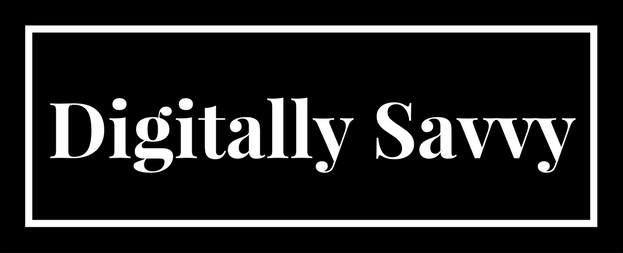
64 Of The Best Channel Marketing Case Studies
July 16, 2015

One of the most attractive things in a business is an effective, scalable marketing channel. Truthfully, it’s not nearly as easy as it sounds.
Exploring whether or not a channel can work for you takes work – a lot of it. Sometimes it takes months to really explore a marketing channel and decide whether or not it is delivering results.
When I advise clients on channels that I believe will be effective for their business, I always start by considering the case studies. What are other businesses doing that is working, and is it something that we can mimic?
Therefore, I’ve organized a list of over 60 case studies, organized by channel, where actual results were delivered.
If you’re in the middle of one of these channels right now, I suggest honing in on the case studies and deciding whether or not you should implement it yourself.
Table of Contents
Content Marketing Email Marketing Influencer Marketing SEO Social Media Viral Marketing Word Of Mouth
Content Marketing
Content is king – as they say. That said, content marketing is a relatively new strategy that is taking the internet by storm as content is being seen as the way for businesses to rank in Google. In fact, a recent survey by Marketing Land found that 89% of businesses doing content marketing say it works. It is extremely cheap and has virtually no barriers to entry.
- Content Strategy Case Study: 36,282 Readers & 1,000 Subscribers
- Case Study ? How an effective content marketing strategy drives online success ? Belfast ? The Tomorrow Lab
- A Case Study: Content Marketing Increases Web Referrals by 50%
- 15 B2B Case Studies Show How Content Marketing Drives ROI
- Content Marketing Case Study: How To Increase Traffic 272% In 30 Days (Without Spending A Penny)
- Case Study: How MSI Data Drives Business with Content Marketing | Search Engine People
- Content Marketing Case Study :: 600 visitors a day from a single blog post | MODassic Marketing
Email Marketing
Content may be king but the money is in the list. Collecting someone’s email address is often seen as the holy grail of marketing, because people are so much more receptive to emails as compared to other channels. Still, it’s important to know what to do with those email addresses after you collect them, which are what these case studies reveal.
- How to launch an online course and make $220,750 in 10 days
- Case Study: Email Marketing with Markree Castle Hotel and GroupMail
- Email Marketing Case Study: How I Generated $40,000 In Sales Without Annoying My Subscribers
- Email Marketing: Microsoft Store uses relevance to increase sends by 300% and email revenue by 600% | MarketingSherpa
- Email Marketing: Simplifying email content increases open rates 48% for B2B company | MarketingSherpa
- 10 Case Studies To Help You Get More Clicks – Email Marketing Tips
- Using Email Marketing to Connect with the Local Community
Influencer Marketing
Influencer marketing is one of the most talked about marketing channels in recent times. It involves identifying potential brand advocates and partnering with them to promote your business. What makes influencer marketing ideal is that you get to tap into the large audience that influencers have amassed. Again, this is a very cost effective channel for reaching thousands of people.
- Luxury Social Media Marketing Case Study Example: diptyque Paris | Affinitive
- What Happens When Guy Kawasaki Tweets Your Post to His Followers? | DrumUp Blog
- Case Study: 30% Conv. Rate with Influencer Marketing
- Company Spotlight – How LeadPages Uses Influencer Marketing To Grow To 25k Customers
- Influencer Marketing Success on YouTube – NordicTrack
- How we grew our website traffic by +400% with influencer marketing ? onalytica
- Award Winning B2B Influencer Content Marketing Case Study & 18 Resources
- Influencer Marketing Case Study: Kmart Holiday Hoopla Contest | WendyPiersall.com

Google has over 1 trillion searches a year, and tapping into that is what Search Engine Optimization is all about. What’s unique about SEO is that it tends to be ongoing. If you are ranking for a set of keywords you can continue to receive traffic long after the “campaign” is over with (as opposed to make other types of marketing channels). See in these case studies how businesses have improved their rankings and increased their organic traffic.
- Negative SEO Case Study: How to Uncover an Attack Using a Backlink Audit | SEW
- Inflow SEO Case Study: 108% YoY Organic Traffic Increase
- How VeriFirst Used Content to Increase Organic Traffic, Leads, and Grow Business
- How Social Media Can Help Organic SEO : 2 Case Studies – Jeffbullas’s Blog
- How We Increased Organic Blog Traffic by 203.5% in Less Than 3 Months – And You Can Too – @ProBlogger
- How To Increase Website Traffic to Over 100,000 Visitors Per Month
- Project POUQ: Increase Organic SEO Traffic by 10,000 Unique Visitors a Month
- White Hat SEO Case Study???How I Increased Traffic to Over 100,000 Visitors per Month ? Medium
- Case Study: One Site’s Recovery from an Ugly SEO Mess – Moz icon-book icon-close icon-conversation icon-envelope icon-external icon-house icon-menu icon-pencil icon-products icon-search moz-logo Tools
- Increasing Organic SEO Traffic by 400,000 Unique Visitors a Month! – YouMoz – Moz icon-book icon-close icon-conversation icon-envelope icon-external icon-house icon-menu icon-pencil icon-products icon-search moz-logo Tools
Social Media
It seems that just about every business has at least one social media profile nowadays, which would make it significantly more popular than content marketing. That said, having a profile is not the same as having a strategy – far from it in fact. What’s unique about social media are all of the different platforms, such as Facebook, Twitter, Pinterest, Instagram, to name just a few. Each has a different audience and requires a different strategy. For example, while Facebook is normally heralded as a great B2C platform, LinkedIn is typically reserved for B2B. While Facebook and Twitter seem to have an equal number of men and women, Pinterest is heavily geared towards females. These case studies will guide you on how to tackle each channel.
- 5 Best Social Media Campaigns of 2014 – Beta21
- How L’Oreal Use Social Media for Recruitment [Case Study]
- ShipServ and one of the most interesting B2B social media case studies – Schaefer Marketing Solutions: We Help Businesses {grow}
- B2B Social Media Case Study: How I made $47 million from my B2B blog – Schaefer Marketing Solutions: We Help Businesses {grow}
- Social Media Launch Saves Cisco $100,000+ Social Media Examiner
- How Red Bull uses Facebook, Twitter, Pinterest and Google+ | Econsultancy
- How Cadbury uses Facebook, Twitter, Pinterest and Google+ | Econsultancy
- The Key Features Behind A Successful Marketing Campaign | Simply Zesty
Video Marketing

Video is a popular media used in marketing campaigns and it’s becoming more and more popular each year as the barriers to entry for video creation lessen. To put things in perspective, every minute 300 hours of video are uploaded to Youtube.
- How Cuisinart Grew Brand Engagement With Interactive Video On Facebook
- Viral Video Case Study of Dollar Shave Club : What We Can Learn ? iMediaConnection Blog
- Succeed with Video Content Marketing: 5 Tips and a Case Study
- [Case Study] How 1 Instagram Marketing Video Increased New Patients at a Bahrain Medical Clinic – Gulf Broadcast [Case Study] How 1 Instagram Marketing Video Increased New Patients at a Bahrain Medical Clinic – Gulf Broadcast
- What It Really Takes For Video Content To Go Viral [Case Study]
- A case study of using video marketing to enhance your brand and help CRO – Smart Insights Digital Marketing Advice
- 5 Examples of Awesome B2B Video Marketing | Vidyard
Viral Marketing
Viral – it’s what everyone wants to go. While there is no way to guarantee virality, there are conditions that increase its likelihood. As you read these case studies notice some of the following attributes. Firstly, many viral campaigns involve video. This is because video is easy to share and easy to digest. A one minute video can convey a whole host of emotions. Additionally, they integrate sharing into the campaign, asking you to tag multiple other people. This prolongs the life of the campaign. Lastly, there is usually something “catchy”. Combine all of these elements and you may just have a viral campaign.
- Viral Marketing Case Study: 17,584 Visitors In One Day
- The ‘Ice Bucket Challenge’: A case study in viral marketing gold – Digiday
- Case Study: Going Viral With Stride Gum | jmarbach.com
- The Old Spice Social Media Campaign by the Numbers
- The Dark Knight: A Case Study of Viral Marketing | PhilTreagus.com | An Entrepreneurs Life?
- Case Study: AcneFree Sampling Goes Viral! ? likeable media
- No make-up selfie cancer campaign raises ?8m in 6 days – Telegraph
- Case Study: How Gangnam Style went viral with a strategic marketing campaign from YG Entertainment | The Drum
- 9,000 Uniques in One Day: A Viral Marketing Case Study – Moz icon-book icon-close icon-conversation icon-envelope icon-external icon-house icon-menu icon-pencil icon-products icon-search moz-logo Tools
Word Of Mouth
Word of mouth is considered the holy grail of marketing. It’s generally one of the least expensive channels – but how do you get people to talk about you? Often, it has to do with getting the big things right; a great product, great customer service, and a reason for people to share. These case studies go in depth on various referral campaigns that capitalize on word of mouth sharing.
- How Intuit Measures the Impact of Social Media Activity on Sales for Small Business Owners, presented by Kira Wampler | WordofMouth.org
- How Word-Of-Mouth On Facebook Can Boost Sales 433% | SocialTimes
- Digital marketing case study – Dettol boosts spray sales 86% in China via mums’ word of mouth – Digital Training Academy
- AAP collects INR 18M using InviteReferrals Referral marketing software
- Word-of-Mouth – Case Study: How One Company More Than Doubled Customer Referrals : MarketingProfs Article
- Social Media Marketing: How a small e-commerce site attracted 293,000 Facebook fans | MarketingSherpa
- Word of Mouth Marketing Case Study: Epson & Sparkplugging | WendyPiersall.com
- Referral Program: 18,000 customer participants create more than 60,000 shares, $100,000 in sales | MarketingSherpa


Press Release Case Study: Using PR For A New Product Launch
Meredith ashburn.
- KWSM Case Studies , Public Relations
In the summer of 2022, our client, a US-based plastic sheeting manufacturer, was getting ready to launch a new mold vapor barrier product. They enlisted KWSM’s PR services to help drive awareness about the launch and leverage this innovative product to set them apart from competitors. For over 13 years, KWSM has been successfully writing and distributing press releases that drive results for our clients. We were confident that getting a comprehensive release into the right hands could be exactly what we needed to jumpstart this product launch.
Press Release Case Study
This client has worked with KWSM for years with a steady number of sales stemming from our digital efforts. When they told us about an upcoming product launch, we knew this was an opportunity to expand their brand awareness to the right audience. For this product specifically, we narrowed our target audience down to home and commercial builders who were looking for advanced technology for mold prevention in crawl spaces.
The client had a limited budget to support this product launch, so we decided to run a strategic PR campaign to get new users into our marketing funnel, which we would then support with weekly blogs, email marketing, and low-budget PPC ads.

To begin, we wrote a comprehensive press release that highlighted the product’s innovative mold prevention technology, educated the audience on the prevalence of mold within homes and why prevention is so important, and provided credibility by showcasing our client’s 25 years of experience providing their customers with high-quality products and personalized service.
Once the release was written and approved by our client, it was time to get eyes on it.
At KWSM, we use two methods of press release distribution to maximize results: putting the release “on the wire” and sending it via email to a custom media list.
In this case, we sent it directly to a list of media contacts that we sourced, including relevant magazines, bloggers, trade publications, and influential personalities in the home and commercial building industries.
The Results
With this type of product, the sales cycle can be quite long as vapor barriers run at hundreds of dollars and builders tend to explore multiple options from competitors before purchasing. However, it took no time at all for results to start coming in after the release was published.
Within 24 hours, the press release generated:
- 81 total pick-ups from Construction Publications
- 233 pages views on the product page
Within 30 days, this product brought in $4K in revenue via online orders.
Since the launch, the product continues to bring in over $2K consistently each month.
“This was the first time in several years that our client was releasing a new product. We were really focused on getting our announcement in front of the top publications their audience trusted as resources. This release began the trajectory for putting our client’s product not only on the first page of Google, but also as the top-of-mind option for construction professionals. It gave us the platform to launch this product directly into the industry and become a staple for construction applications.”
- Brianna Zambrano, Senior Digital Marketing Strategist, KWSM
Our client reports that since the campaign’s launch in August, they have sold over 180 rolls of the new product and brought in about $55k in revenue. All in all, we consider this a very successful launch, especially considering the limited budget for digital promotion.
You can find more KWSM press release case study examples here .
Consult Our Team of PR Professionals
If you’re looking to generate some buzz around your upcoming product launch or important company news, a press release can be a lower-cost, high-reward opportunity. Our team will help get the right eyes on your story and shine a light on what sets you apart from competitors.

Fill out the form below to start your conversation with KWSM.
Blog Categories
- Analytics & Reporting
- Artificial Intelligence (AI)
- Content Marketing
- Copywriting
- Digital Advertising
- Digital Marketing Strategy
- Email Marketing
- Employer Branding
- Influencer Marketing
- Inside KWSM
- KWSM Case Studies
- Lead Generation
- Public Relations
- Reputation Management
- Social Media
- Text Message Marketing
- Video Marketing
- Website Design
- Website Management
[email protected]
(949) 436-5173.
ADA Accessibility | Privacy Policy

PRODUCT LAUNCH CASE STUDY
The power of hyper-targeted email to reach b2b customers., the problem: how to market new b2b products when traditional channels don’t work..
When one of the world’s leading manufacturers of building products introduced a new commercial product line in a completely different category, they faced a significant hurdle. They needed to expand awareness of the new products by engaging targeted customers with educational information and compelling offers. Unfortunately, their target buyers including property managers, facility managers, and construction contractors proved very difficult to reach through traditional advertising channels. Trade shows and industry publications had insufficient access and reach to their new customer audience.
There wasn’t an obvious, cost-effective way to reach this specific set of decision makers.
The Solution
Hyper-Targeted Email Advertising Successfully Delivered Relevant Messages to Property Managers and Contractors.
The client’s agency tapped Future Flow Media to try permission-based targeted email advertising as a new channel to engage this hard-to-reach audience. Using our hyper-targeted email advertising database with detailed profiles for over 51 million business subscribers, the client now had the unprecedented ability to target B2B messages using various criteria, including:
- Company size and revenue
- Job title/role
- Geography and more
Empowered with this audience targeting and message delivery capability, and the full-service support from the Future Flow Media team, the agency crafted and executed permission-based email campaigns to:
- Create new product awareness
- Provide special offers and promotions
- Drive direct response calls and orders
The Results
A Rise in Brand Awareness. Increased Orders. Dramatic Growth in Their Email Marketing List.
Thanks to Future Flow Media, the campaigns hit the mark. Compelling messages and offers successfully got the attention of the otherwise hard-to-reach facility managers and contractors responsible for relevant purchase decisions. The agency was able to test multiple offers and creative approaches while measuring campaign effectiveness and overall ROI.
The Optimized Campaigns Yielded:
- 100% email delivery
- A record-setting number of coupon and information kit downloads
- A significant lift in brand awareness and interactions
- Increased orders through direct response
- A dramatic growth in the company’s email opt-in list that enabled subsequent cross-selling and remarketing campaigns
Delighted with the role that hyper-targeted email advertising played as a catalyst for the growth of their new product line, the company committed to an ongoing permission email advertising strategy. The agency selected Future Flow Media as their preferred partner for future projects with all of their clients.
More Case Studies

Hotel Case Study

Tourism Against the Odds

Cross-Channel Hyper-Targeting
Discover execution you can rely on..
Learn how Future Flow Media can help you experience better results.
CASE STUDY: Transforming Global Customer Interactions with NLU
This case study explores how Welo Data partnered with a major e-commerce giant to support the launch of its flagship Natural Language Understanding (NLU) product.

This case study explores how Welo Data partnered with a major e-commerce giant to support the launch and scalability of its flagship Natural Language Understanding (NLU) product.
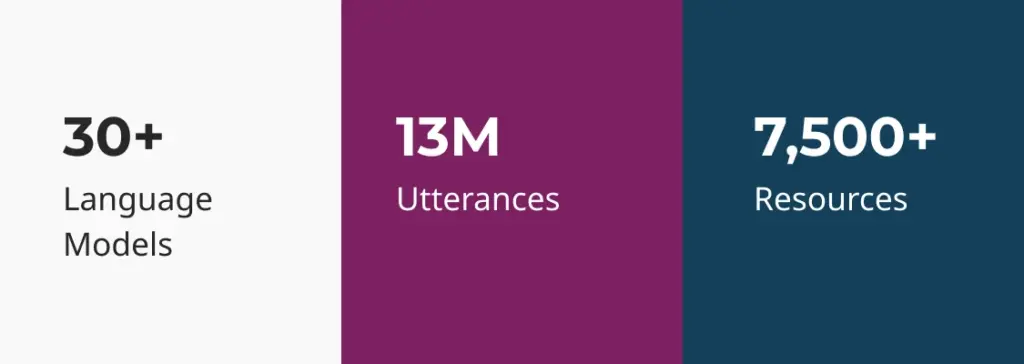
Together, we achieved:
- Testing & ramping 30 crowd teams during 4-month sprints spanning 3 years
- Delivery of 13 million high-quality utterances
- Managing 7,500 resources in all time zones, driving a 24/7 production stream
Scroll 👇 to read the case study. And to discover more about how Welo Data can upgrade your AI, just click here >>>
The Challenge
In the competitive realm of e-commerce, the launch of a flagship Natural Language Understanding (NLU) product represented a significant step forward for our client. This initiative aimed to refine customer interactions through enhanced AI-driven conversational models across 30 languages, spanning multiple domains.
A particularly challenging dimension of the project was the need to consistently deliver written data as if it were generated by an automatic speech recognition model. The partnership with Welocalize was pivotal in overcoming the inherent challenges of such an ambitious global rollout.
Overcoming Multifaceted Challenges
The core challenge lay in the requirement for vast, diverse utterances covering both written and spoken language modalities, tailored not just linguistically but culturally for each target locale. This complexity was compounded by the need for nuanced intent discovery within eight subject areas, all under the pressures of an aggressive timeline.
The Solution
The collaboration between the client’s data science teams and Welo Data led to the development of a robust, scalable data pipeline. This strategic approach was distinguished by its focus on crafting solutions that were directly beneficial to the client’s objectives:
- Enhanced Data Accuracy and Relevance : By aligning closely with the client’s scientific teams, the project ensured that data guidelines were optimized for the highest levels of accuracy and relevance. The Welo Data team’s expert computational linguists uncovered key gaps in the client’s data planning related to language-specific nuances. This collaboration resulted in the delivery of data that directly supported the nuanced requirements of the NLU product across each language.
- Global Scalability with Local Sensitivity : Recognizing the importance of cultural and linguistic accuracy, the project utilized advanced NLP tools and workflow controls tailored to each locale. This ensured that the data reflected the unique characteristics of each market, enhancing the product’s effectiveness and user satisfaction.
- Round-the-Clock Production : The operational strategy successfully managed a global team of 7,500 resources, achieving continuous production. This capability ensured that project milestones were met without sacrificing data quality or worker well-being.
- Direct Benefits to the Client : The project delivered 13 million high-quality utterances across 30 languages. This vast, rich dataset was instrumental in refining the client’s NLU product, directly contributing to its success in providing more accurate, culturally resonant customer interactions.
The Results
The success of this collaboration lies in its direct impact on the client’s ability to launch a sophisticated NLU product that meets the diverse needs of its global customer base. By delivering a product capable of understanding and engaging customers in their own languages and cultural contexts, the client has set a new standard for AI-driven customer interaction in the e-commerce industry.
This case study exemplifies how strategic partnerships can overcome the complexities of global product launches, delivering tangible benefits to customers through meticulous planning, innovative solutions, and a deep understanding of global market dynamics.


IMAGES
VIDEO
COMMENTS
Amazon Kindle Fire. Bristly. From amazing ebikes and dog toothbrushes to skateboards and the Amazon Kindle Fire, let's see how great products launch. 1. VanMoof Electrified S2 and X2. Year of ...
2. Less is More. Social media is not about quantity but quality. Starbucks follows the "less is more" principle to maintain the quality standards, even in the caption. Spamming followers' feeds with constant posting is a big no-no. Starbucks shares 5-6 posts per week on Instagram and 3-4 weekly posts on Facebook.
Here are 7 case studies to inspire your own strategy. As a brand, orchestrating a successful product launch is a lot like getting up on stage as a stand-up comedian. No matter how confident you are that people will like your product and you'll have a successful product launch, you can never quite shake the fear that all you'll hear is crickets.
Results: After they started to launch the audience-friendly videos, they saw monthly video views jump from 50,000 to 1 million in mid-2017. Takeaways. ... In 2019, Major Impact Media released a case study about a real-estate client that wanted to generate more leads. Prior to working with Major Impact, the Minneapolis, Minnesota brokerage hired ...
3 winning social media marketing case study examples. Now that we've gone over the components of a winning social media case study, let's check out some real world examples. 1. "How ERA Belgium Provides Great Content for Franchise Businesses with Kontentino," by Kontentino.
Here are five of the best brands on social and what I think you can learn from them: 1.Mercedes Benz - Repeated, successful social media marketing campaigns. Mercedes Benz seem to win every time with their social media campaigns. The one that stands out to me was back in 2013 when they created what I still believe to be one of the best ...
A product explainer video is a necessity when you're trying to sell a product or a service that's unusual. You may need to explain to your customers what your product does better than the competition or simply explain to them the problem that your product is meant to solve. 7. Reach Out to Your Existing Customers.
With #BeTheOne, Oriflame managed to create conversations around its new range in a cluttered market. The brand saw 98% hike in avg engagement on Instagram. A look at the product launch case study. The idea was to make both, end-consumers and consultants make aware of Oriflame's #TheOne range during the festive season.
A key part of Providence's rebranding strategy was to time the external launch with fall open enrollment. That way community members could experience the new brand in a cohesive manner while enrolling for their benefits and services. To promote open enrollment, Providence developed a media campaign that showcased time-lapsed drone footage of ...
Launch Media Case Studies. Browse Launch Media case studies and success stories to help make the right purchasing decision. 1-12 of 12 results. Great Minds - Customer Case Study. Read Case Study. Insect Allies: U.S. Response to Food Supply Threats. Read Case Study. CSRS Inc. - Customer Case Study.
The revamp marked the launch of the brand's new social strategy "rooted in optimism, uplift and connection." and was conceived to celebrate World Kindness Day (observed annually on November 13th). Coca-Cola went dark on its Facebook, Instagram and Twitter accounts on November 12th, only to re-emerge on World Kindness Day 2018; sharing ...
The Formula. Beauty brand launch campaigns tend to follow a 3-part formula: 1. Face. Beauty and fragrance consumer marketing campaigns overwhelmingly have a "face" - a celebrity or model demonstrating the product's promised outcome, and semiotically, the product's intended audience.
Launch week activities. Since the bestsellers lists measure sales during the first week a book comes out, launch week activities are important. They produced their big launch event in Nashville like they would a TV show. It had a custom backdrop, five cameras, and live-streaming to the web. There were 1,000 people physically at the event.
Send out the case study to your email subscriber list. Be specific and target groups that would most likely be interested in the case study. Launch social media campaigns. Share your case study on your social media platforms. Use eye-catching graphics and engaging captions to draw in potential readers.
Open up with a summary that communicates who your client is and why they reached out to you. Like in the other case study examples, you'll want to close out with a quantitative list of your achievements. 16. " NetApp ," by Evisort. Evisort opens up its NetApp case study with an at-a-glance overview of the client.
At this launch, journalists were able to ask questions, inquire with executives and experience Netflix in a more intimate and immersive manner. Props, photo-booths, swag bags and a customized Netflix TukTuk added to the lively, bold and energetic atmosphere at this Netflix House Media Launch event.
The Tomorrow Lab. A Case Study: Content Marketing Increases Web Referrals by 50%. 15 B2B Case Studies Show How Content Marketing Drives ROI. Content Marketing Case Study: How To Increase Traffic 272% In 30 Days (Without Spending A Penny) Case Study: How MSI Data Drives Business with Content Marketing | Search Engine People.
Our breadth of services were utilized for the launch: full video production, photography, scriptwriting, asset creation for on-stage launch videos, social media teaser content, and launch and sustainment assets. This case study delves into our strategic approach, from the initial concept through to execution, which not only maximized reach and ...
26. In the summer of 2022, our client, a US-based plastic sheeting manufacturer, was getting ready to launch a new mold vapor barrier product. They enlisted KWSM's PR services to help drive awareness about the launch and leverage this innovative product to set them apart from competitors. For over 13 years, KWSM has been successfully writing ...
Thanks to Future Flow Media, the campaigns hit the mark. Compelling messages and offers successfully got the attention of the otherwise hard-to-reach facility managers and contractors responsible for relevant purchase decisions. The agency was able to test multiple offers and creative approaches while measuring campaign effectiveness and ...
Tim Draper. Sarah Mavrinac. Neil Jones. David Perry. Four years ago, Diane Ashton and Sundeep Lal were working together at MIT on a titanium extraction project. Durable and highly heat resistant ...
Digital/Launch Highlights Live streamed global launch from Tokyo Immersive projection-mapped reveal sequence Interactive salon with driving engagements Breakout sessions with designers and engineers Results 5,600 attendees 515,000 Live Streams Over 500,000 YouTube Views 4,000 Media Mentions Generated 66,000 Social Posts with 1.1 Billion Impressions As a pioneer in mass-market Electric Vehicles ...
This case study explores how TTT and Haier launched the second season of their Mother's Day campaign, Mothership. Through relatable storytelling and modern communication, the campaign reached 1.3 million users. By Social Samosa. May 30, 2024 13:12 IST 3 Min read. Case Studies.
The goal. Choice Furniture Superstore (CFS), a Leicester-based furniture retailer shipping nationwide, is among the UK's fastest-growing furniture destinations known for its high-quality furniture and customer service. The brand embarked on a mission to revolutionize its sales process. From enhancing lead generation via targeted online ...
This case study explores how Welo Data partnered with a major e-commerce giant to support the launch and scalability of its flagship Natural Language Understanding (NLU) product. Together, we achieved: Testing & ramping 30 crowd teams during 4-month sprints spanning 3 years. Delivery of 13 million high-quality utterances.
Case studies are in-depth investigations of a person, group, event, or community. Typically, data is gathered from various sources using several methods (e.g., observations & interviews). The case study research method originated in clinical medicine (the case history, i.e., the patient's personal history). In psychology, case studies are ...
May 30, 2024. By Delaney Dixon. Transportation. Source: NASEO. NASEO, AASHTO, and Atlas Public Policy released the third in a series of case studies on the first phase of the National Electric Vehicle Infrastructure (NEVI) program, " NEVI Implementation in Ohio: Case Study .". The case studies are intended to delve deeper into states ...
Social media monitoring projects are increasingly important to analyze the information environment surrounding an election. To gain a deeper understanding of how online narratives impact the credibility of an election requires a large team to analyze a large amount of data.Designing projects with the mental and emotional burden that reviewing hateful content can create in mind allows ...
Case study: Jamworks. Jamworks is a powerful AI notetaking and productivity tool that records, transcribes, summarizes and generates meaningful insights from meetings, conversations and lectures. Having worked with AI for several years, the Jamworks team is convinced that the technology has the power to transform the way we study and work ...
Through a thematic analysis methodology, three themes emerged, namely: Experiences, Challenges, and Learning. This study confirms the usefulness of COIL as a pedagogy for internationalization in higher education and the development of professional skills, by incorporating the intercultural dimension in the curriculum within the virtual space.